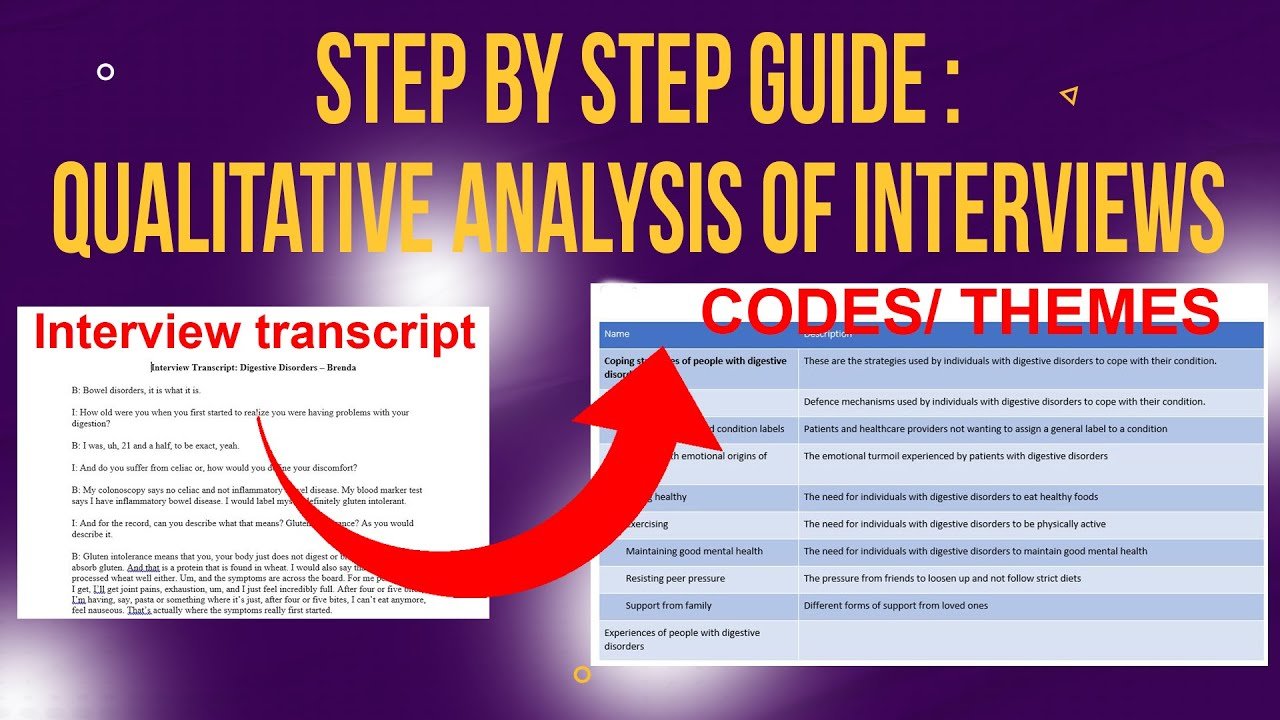Introduction
In this article I’m going to show you how to conduct reflexive thematic analysis using N-Vivo.

This is a step-by-step article, that means that we are going to follow the six-steps proposed by Braun and Clarke to conduct reflexive thematic analysis so that we are able to go from raw transcripts like this.

To a complete findings report like this.

The steps that we are going to follow to conduct reflexive thematic analysis were proposed by Braun and Clarke in their 2022 book titled Thematic Analysis, A Practical Guide.
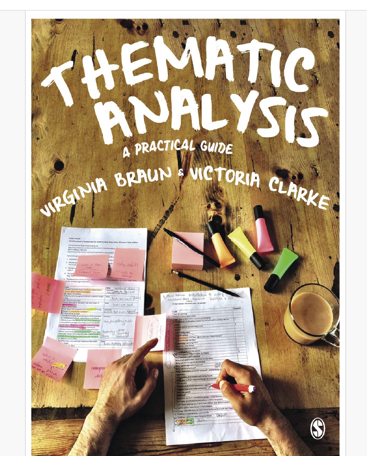
These steps include:
1. Familiarizing with the data
2.Generating initial codes
3. Generating themes.
4. Reviewing themes.
5. Defining and Naming themes.
6.Producing their report.

My name is Bernard Mugo. I like to refer to myself simply as an academic.

In the past three years, I’ve helped more than 200 PhD students analyze qualitative data and finally complete their thesis or dissertations.
In the course of helping such a large number of students, I’ve gained invaluable experience in the best practices that you can use to perform qualitative analysis of your interviews and be able to retrieve quality findings.
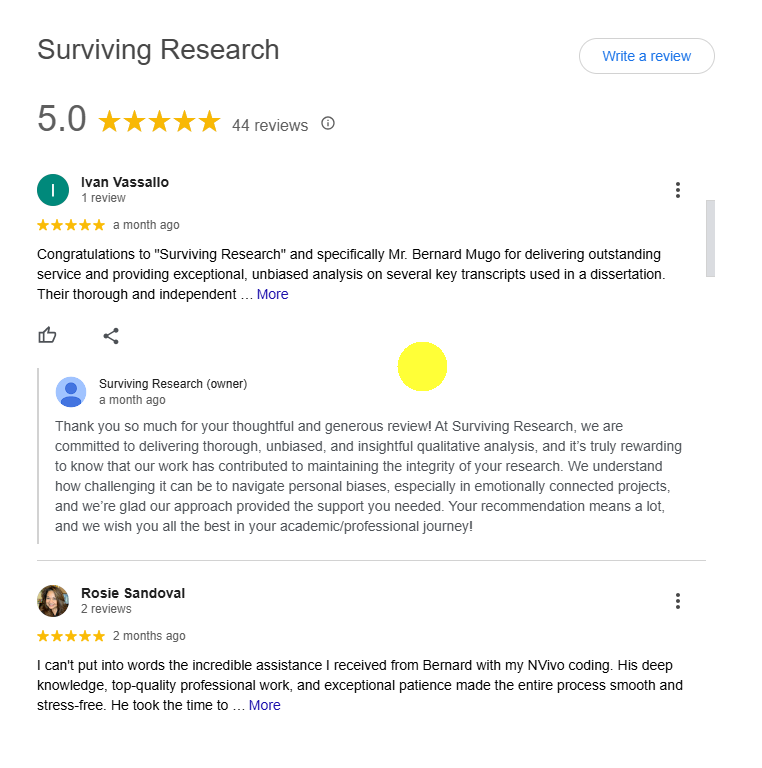
Introduction to Reflexive Thematic Analysis
Before we go through the six-steps proposed by Braun and Clarke on how to conduct reflexive thematic analysis, I would like to clarify why this approach has the word “reflexive” which is a new addition to what was initially referred to as the Braun and Clark six steps of doing thematic analysis.
Reflexive thematic analysis as proposed by Braun and Clarke differs from the general approaches of doing thematic analysis because it emphasizes reflexivity of the researcher.
the reflexivity of the researcher simply means that the researcher has to remain aware of their experiences, background, perceptions, environment and general biases that may affect their interpretation of certain qualitative data.
For example a researcher might have been born from a privileged position or even belong to a certain gender for example a man evaluating issues related to women which may contribute to introducing biases in their interpretation.
In reflexive thematic analysis, Braun and Clark advocate for the researcher to maintain reflexivity by noting down all the influences that may affect their interpretation of data in documents called reflexive journals.
So when conducting reflexive thematic analysis, a researcher has to keep a reflexive journal which is simply notes on their objective thoughts and feelings as they code data and the changes in their thoughts as they analyze the data.
the researcher also notes down the biases in reflexive journals.
Now all these issues which are written in reflexive journals during the process of reflexive thematic analysis should be highlighted in a thesis or dissertations or even a research paper in the section known as the role of the researcher.
By keeping reflexive journals, a researcher is able to maintain reflexivity which is important in conducting reflexive thematic analysis.
Examples of Reflexive journals
Before we begin conducting reflexive thematic analysis through the six steps highlighted by Braun and Clarke, let’s look at some examples of Reflexive journals that are given in their book.
so that we can understand what kind of journals we should keep as we continue to conduct reflexive thematic analysis.
These are reflexive journal entries.

You can see they begin with a date and then this researcher is reflecting on their first focus group.

Lets read

I had my first focus group today after the group.
I did try to write some reflections, but I was feeling so full and heavy with emotion.
I needed some time to process what I was feeling.
Having had some time to do this, I now know I was simply overwhelmed with the emotional content of the focus groups.
Through the focus groups. I was shocked at how often the participants experiences mirrored my own and how their feelings were similar to mine.
I also felt grateful and humbled by their openness.
I’m not sure if I would’ve been so honest, willing and comfortable to talk about my own vulnerabilities in a group to that extent unless it was a friendship group.
I admire their honesty and courage.
I think that however I was reluctant to probe deeper with some members of the group because of my own uncomfortable feelings about sharing my own emotions with others.
I feel that this limited the types of questions that I asked in hindsight.
I could have asked for clarification on several comments, which would’ve provided more insights.
It’s important for me in the next focus group to not be afraid to probe deeper.
This is a reflective journal that this researcher wrote down.
hese are the kind of reflexive journals that we should be writing when we are conducting reflexive thematic analysis according to the six steps proposed by Braun and Clarke.
Let’s look at just another random example of a reflexive journal so that we may proceed
this one they entered it on the 15th of January in the year 2017.

I think I now have a hang of coding.
It was very tricky at the beginning I was not sure what I was doing.
My code seemed more like sentences than codes.
I was also finding the coding unbelievably slow since I was constantly evaluating and re-evaluating every code to make sure that I was capturing what participants are saying rather than imposing my own assumptions into the codes.
Although it’s currently going slightly faster since I’m more familiar with the coding process, one topic that is jumping out at me is the participants’ perceptions of black men.
I find it interesting how they were speaking about them in such a negative way almost burdensome.
They implied how black men lacked emotional strength and thus felt that being strong was not a choice but a necessity since it compensated for the black man’s inability to be emotionally strong.
Basically these are just examples of the kind of reflexive journals that we should be keeping when we are conducting reflexive thematic analysis by Braun and Clarke.
Having differentiated reflexive thematic analysis from other general approaches of conducting thematic analysis, let’s go through each of the six steps proposed by Braun and Clarke on how to conduct reflexive thematic analysis using N-vivo.
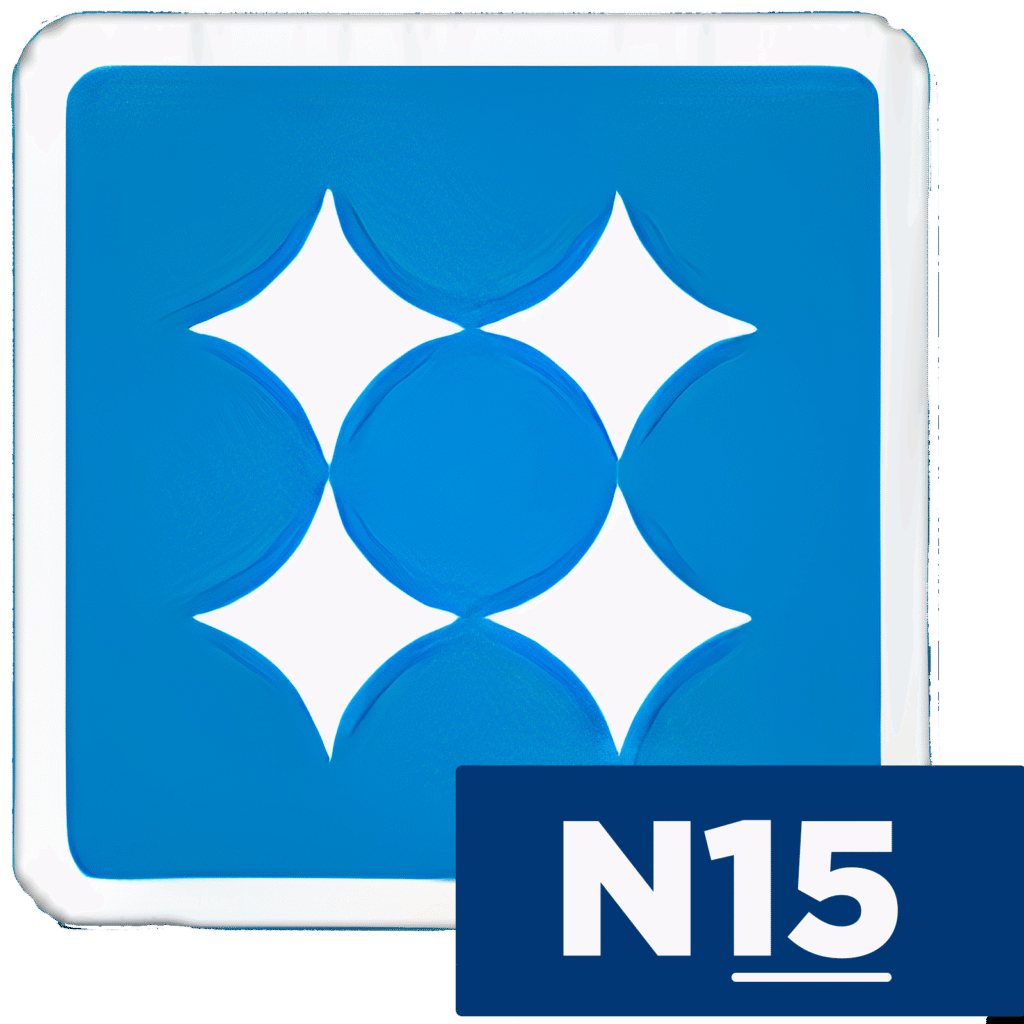
For the purposes of this article, we are going to be using N-vivo 15 to conduct reflexive thematic analysis.
Although I’m using this version of the software which is the latest in the year 2025, you can use previous versions or later versions in the future to conduct reflexive thematic analysis following the same steps.
Now for this article, the example study that I’m conducting is student views on teaching strategies used in a college.

This is someone who went and collected their views on teaching strategies used in a certain college.
I’m going to be analyzing two transcripts and then we are going to do the six-steps of Braun and Clarke in these two transcripts.
Familiarizing with the data
So the first step would be familiarizing with the transcripts.
In this step, I would go and read the transcript like a story.
So transcript number one or student one, two and three I read like a story and I note things that are coming out just short notes.

So that’s the first step of the Braun and Clarke six-step framework for doing reflexive thematic analysis which is familiarizing with the data.
Generating initial codes
Now let’s go to the second step of the Braun and Clark six-steps of conducting reflexive thematic analysis which is generating Initial codes.
To generate codes, I want to give an example of a code as I always do.
So I give you examples of codes then I define what a code is and then we go conduct the coding in N-vivo.
Let me go and find an example of a code then I define a code for you.
If you read other articles I normally give these examples so many times but I don’t get tired because I understand that some people this might be the first transcript they are reading,
so I have to repeat.
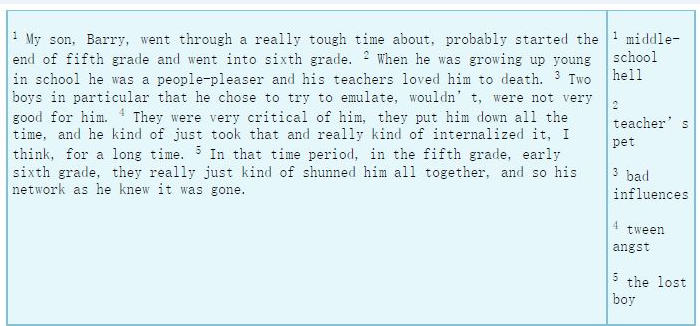
Here is an extract I got from a book title the Coding Manual by Johnny Saldana.
I want to read this paragraph for you and then give you an example of codes and then we define what a code is.
My son, Barry, went through a really tough time about, probably started at the end of fifth grade and went into sixth grade.
When he was growing up young in school he was a people pleaser and his teachers loved him to death.
Two boys in particular that he chose to try and emulate wouldn’t were not very good for him.
They were very critical of him. They put him down all the time and kind of just took that and really kind of internalized it thing for a long time.
In that time period in the fifth grade early sixth grade, they really just kind of shunned him all together.
And so his network as he knew it was gone.
So let’s look at some codes.
If you read the first sentence my son Barry went through a really tough time about probably started at the end of fifth grade and went into sixth grade this person coded this as middle school hell.
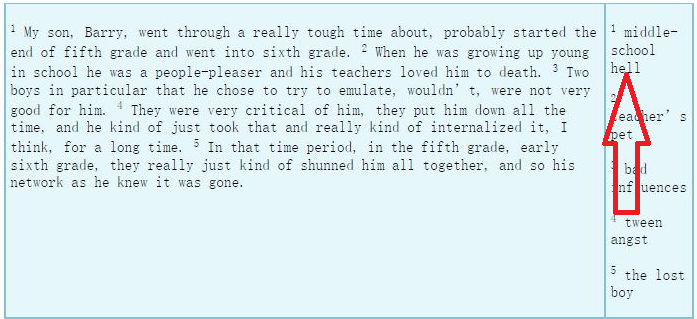
That means that that’s an interpretation of what they went through.
That’s called a code.
Let’s look at another example of a code second sentence, When he was growing up young in school, he was a people pleaser and his teachers love him to death. So teachers pet, that’s another code teachers pet.
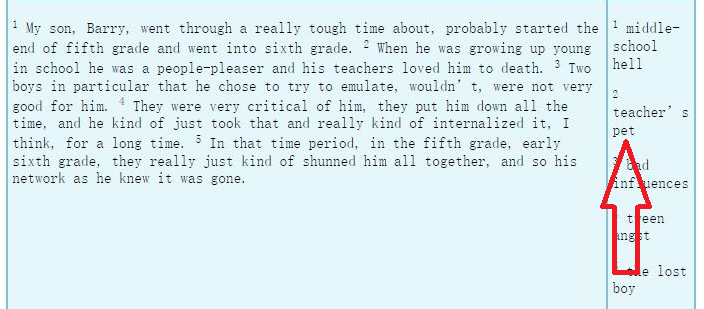
Let’s look at that sentence, Two boys in particular that he chose to try and emulate wouldn’t were not very good for him.
That’s another code bad influences.
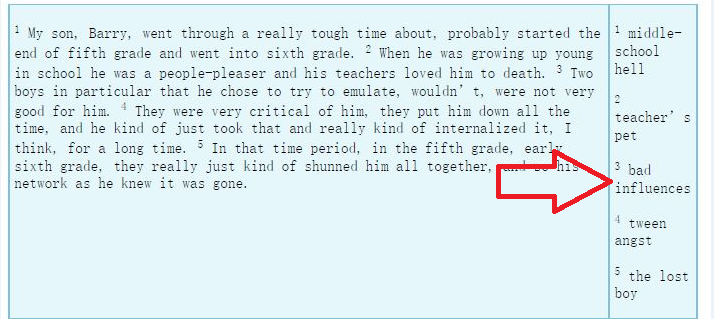
let’s keep going.
They were very critical of him they put him down all the time and he kind of just took that and really kind of internalized it I think for a long time, that code is tween angst.
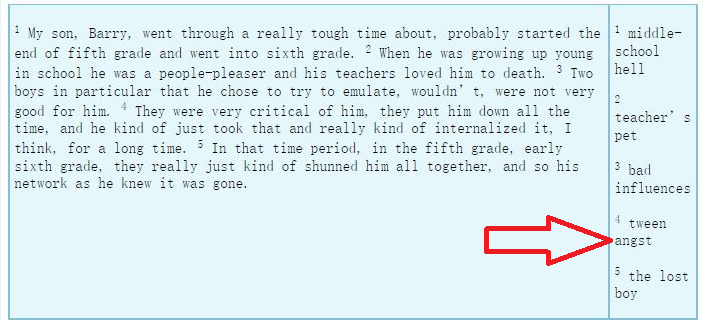
And then the fifth one is in that time period in the fifth grade early sixth grade they really just kind of shunned him all together and so his network as he knew it was gone.
so the lost boy.
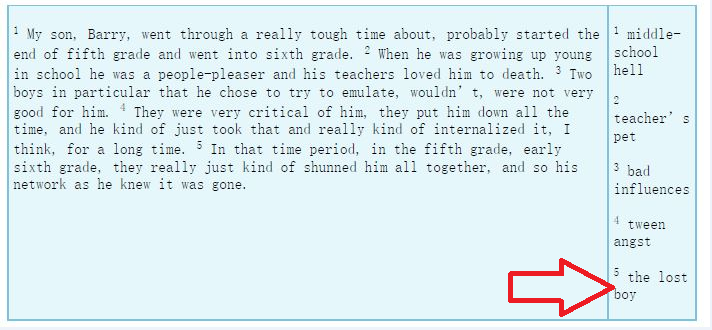
When you look at those codes, they are like interpretive statements or labels to what this author considers to be important to their research objectives.
Let me define a code for you.
A code is a label or an interpretive statement to any information that’s important to our research question or objective.

When you look at this definition of a code, we should know that we only code information that’s important to our research objectives and questions.
And then the way we code is by tagging it with concise labels.
We tag statements said by participants with concise labels and they must be interpretive.
They must not be abstract.
Now having defined codes and having shown you an example of a code, let’s go and open and N-vivo.

Now this is N-Vivo 15, I am using the latest version in the year 2025.
So if you’re reading this in the future probably there’s a newer version of N-Vivo, but you don’t have to worry because these soft-wares are all the same.
We are going to be doing the same steps.
So the software may change but the steps will not change.
This is the opening menu in N-Vivo.
I start by clicking on new project and I call this, RTA project one, this is just a random word or this is what we are doing, We are doing reflective thematic analysis so I name the project the way I want.
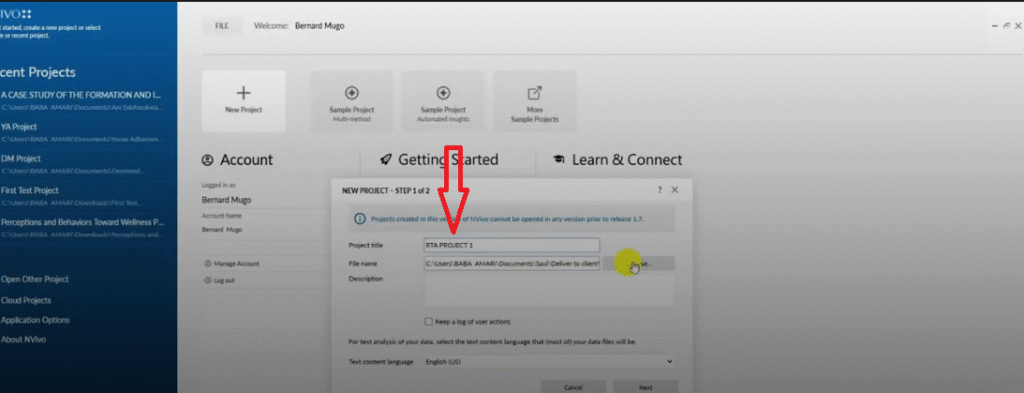
Then I save a project in the folder that I need.
Then I click on Next.
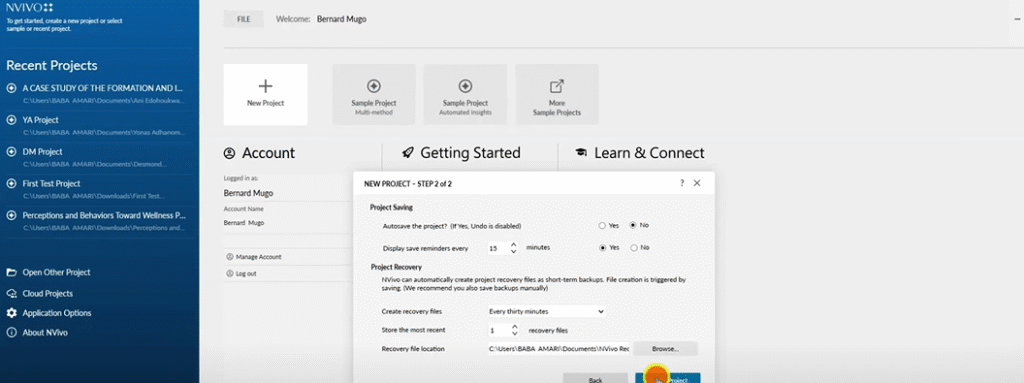
Don’t click on Auto save because N-Vivo sometimes can crash and you can lose your work.
Imagine coding for three days and you lose your work.
So put auto save and click no and go to display every reminder I like 15 minutes and click yes.

This is an insurance policy so that you never lose all your work, so that N-Vivo will keep prompting you to save your work.
That’s how we open N-Vivo.
When N-Vivo opens, this is what you’re going to see.
You’re going to see three main menus.
There’s a top menu with:
1. File
2. Home
3. Import
4.Create
5. Explore
6.Share
7.Modules
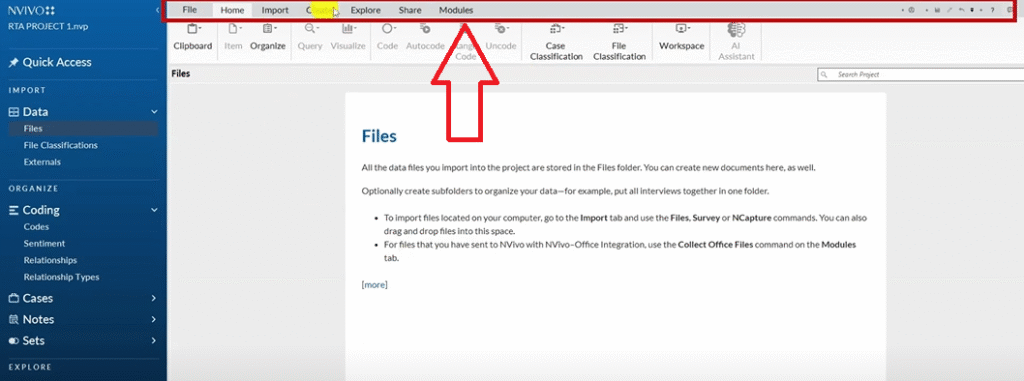
There are these functionalities.
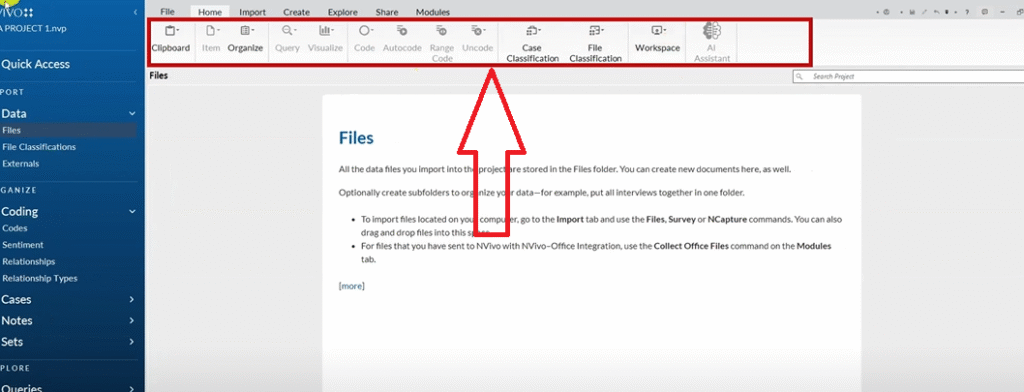
and there is a blue menu.

Now for a beginner I want you to focus on the data section and the coding section.
When you focus on the data and the coding section, I want you to focus on files and codes.
Files is where we are going to import our transcripts and codes is where we are going to begin coding our data.
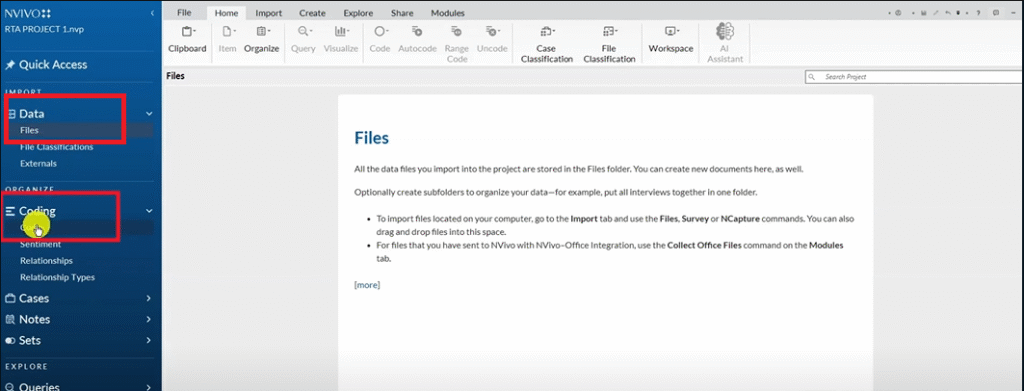
Remember I just showed you an example of a code and remember this is the second step of Braun and Clarke six-step framework for doing reflexive thematic analysis, which is generating initial code.
So ideally, if I come here and click on file section.
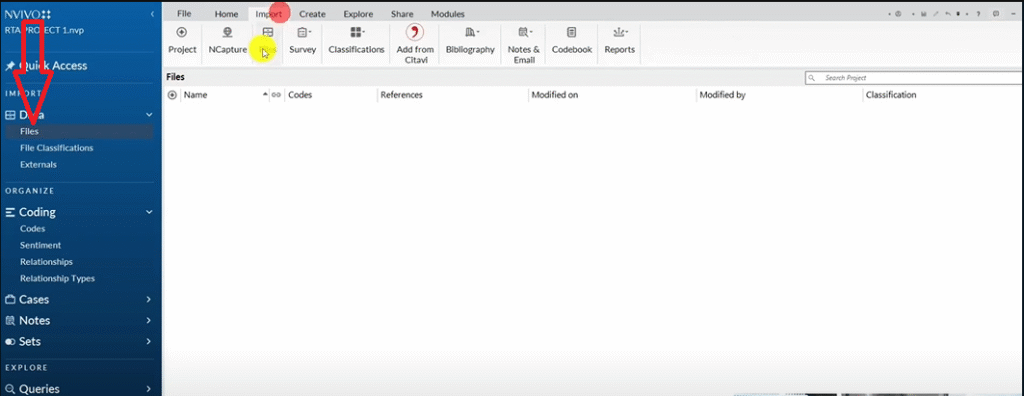
Then go to import.
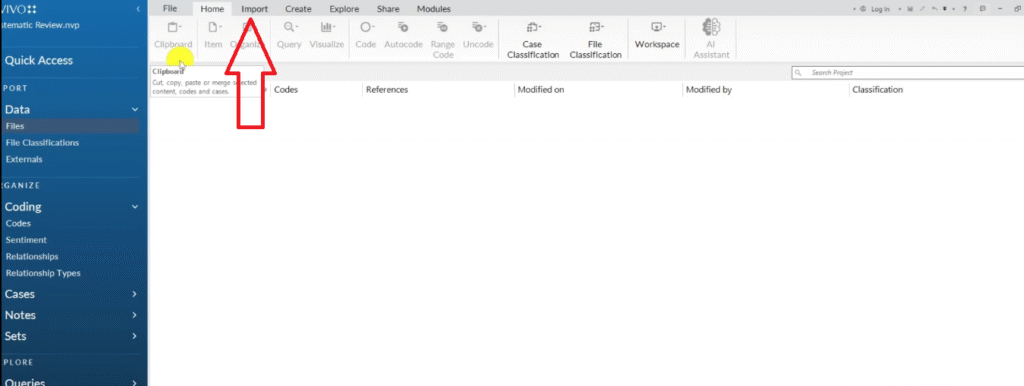
Then go to files
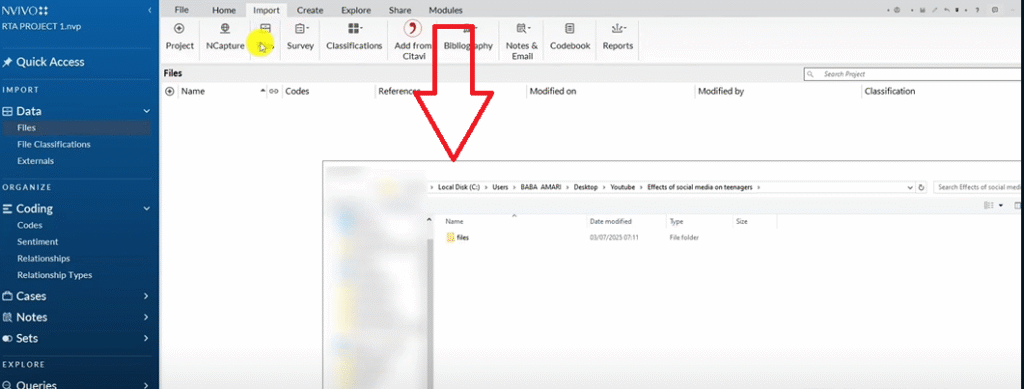
Then I can grab the files student one, student two and three open and import.
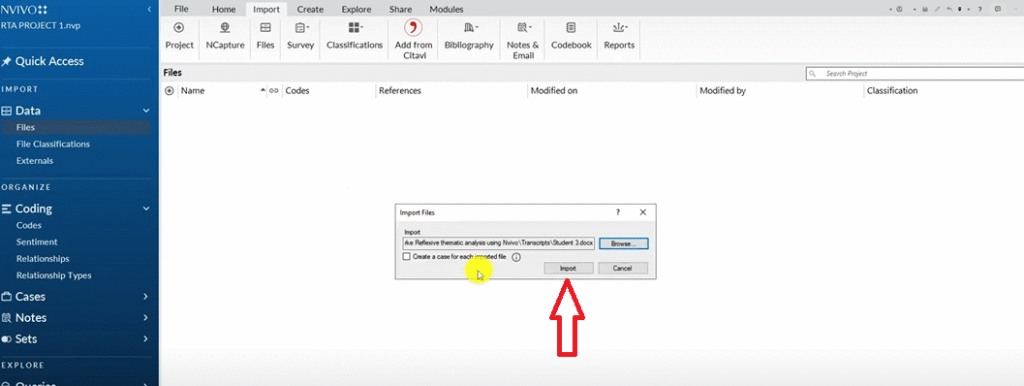
So that’s how we import transcripts into N-Vivo.
We either use the import button which is at the top here.
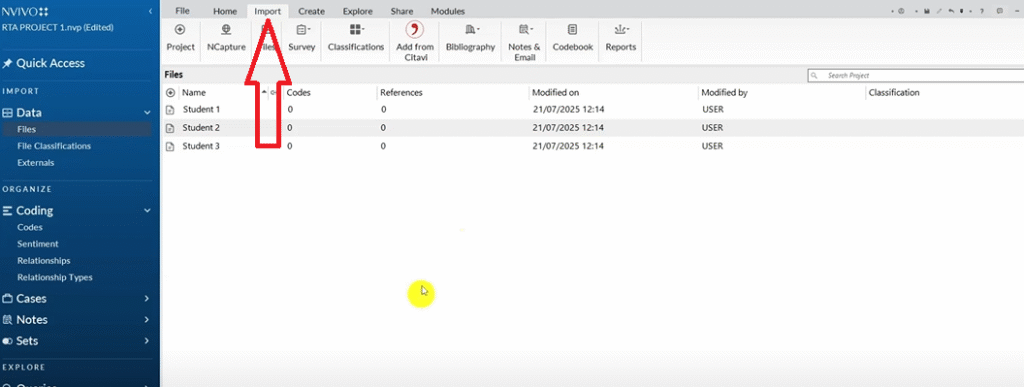
Or we drag and drop the files into the files section.
Now I’ve imported my files, to open the file I double click on it.
So if I double click on student one, you can see the file here.
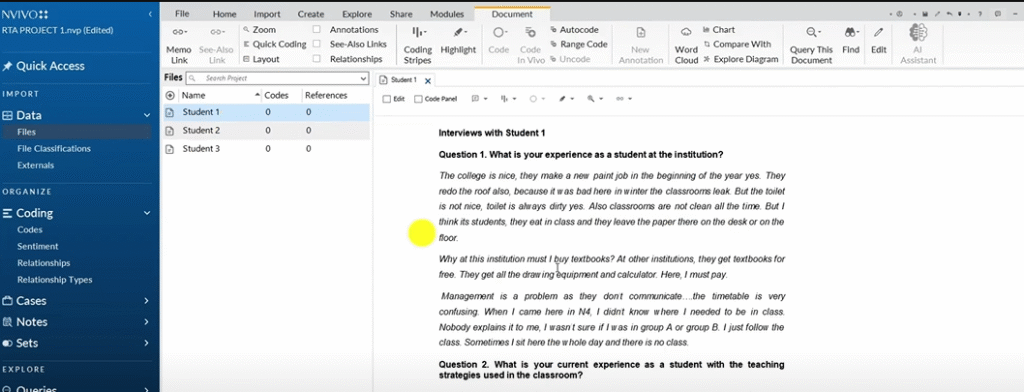
Now I want to go and generate initial codes which is the second step of the Braun and Clarke reflexive thematic framework.
I click on the code section, I right click in the code section and create a new folder.
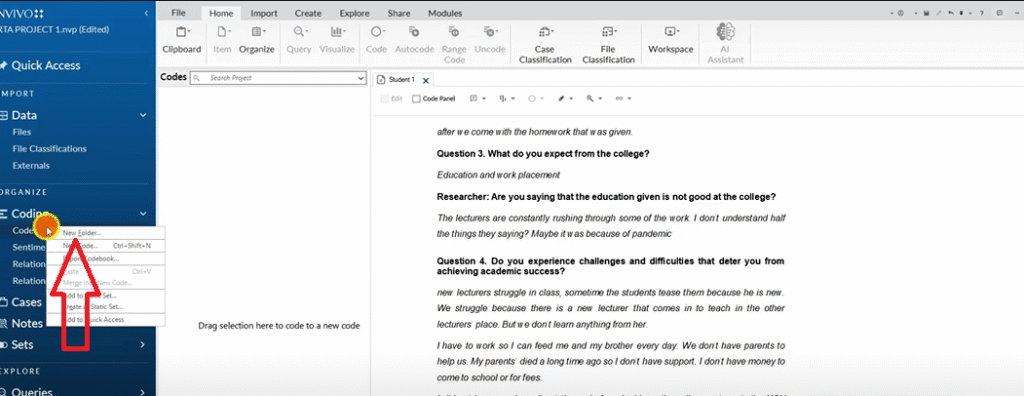
I call this initial code.
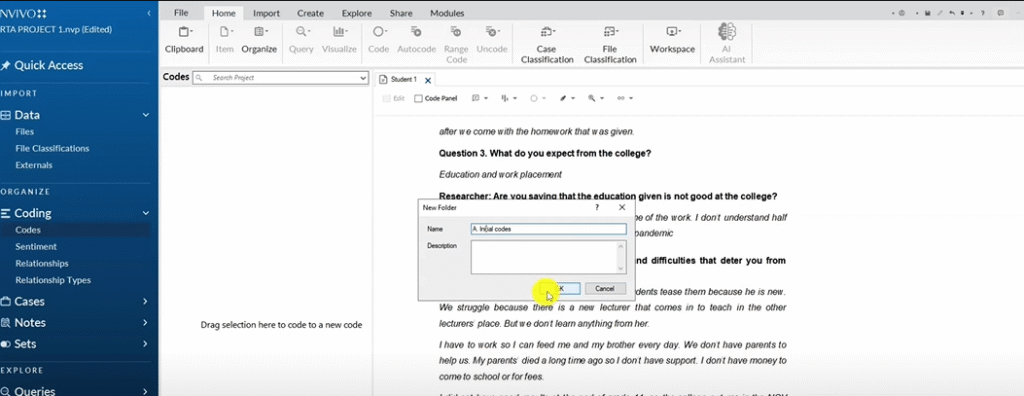
This is where I’m going to put all my initial codes.
Let’s start coding.
Remember reflexive thematic analysis by Braun and Clarke is an inductive approach of doing thematic analysis.

By inductive we mean that we allow the data to give us the code.
So we read the data or we go into the data with objective mind and objective thoughts and we code the data with an open mind.
And then we combine the code to form themes.
So themes come from the data.
Now I have 2 ways which I like capturing information.
First I can use a question as containers or I can use colour codes.
For example in this case we only have six questions.
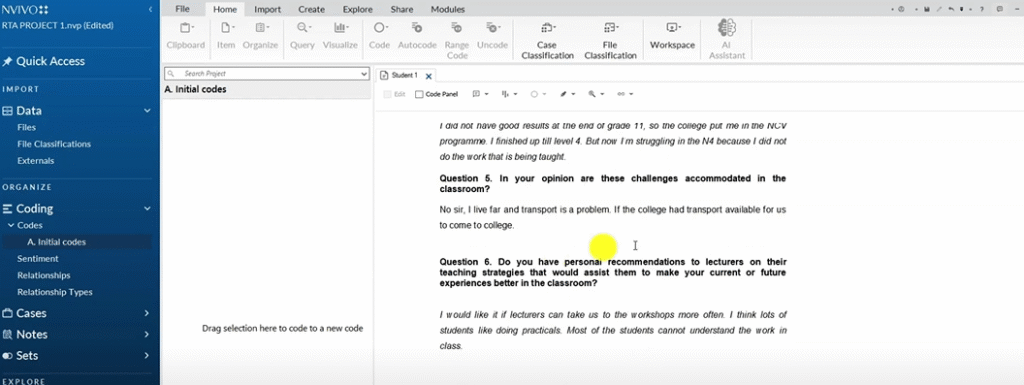
So if I go and open the questions in the Word document and for instance I say for question one is going to be red.
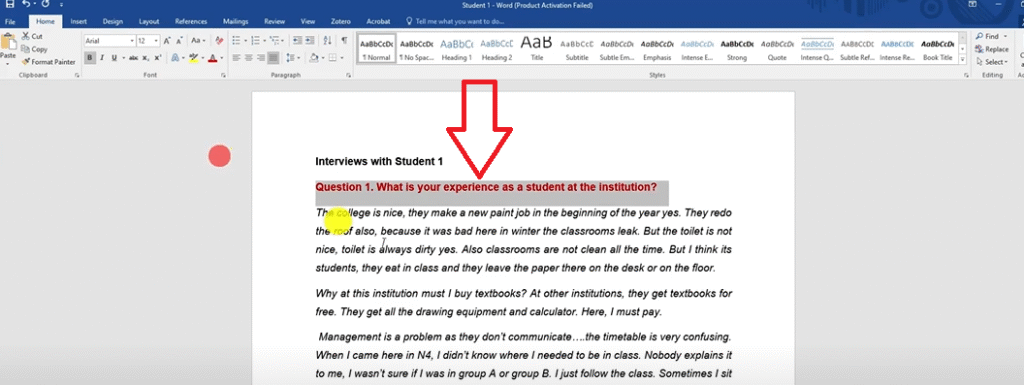
Question two it’s going to be color green.
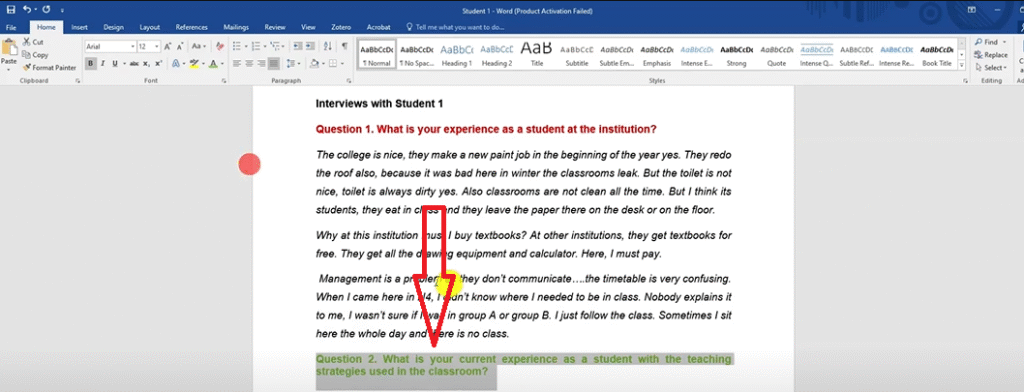
For question three it is going to be color blue.
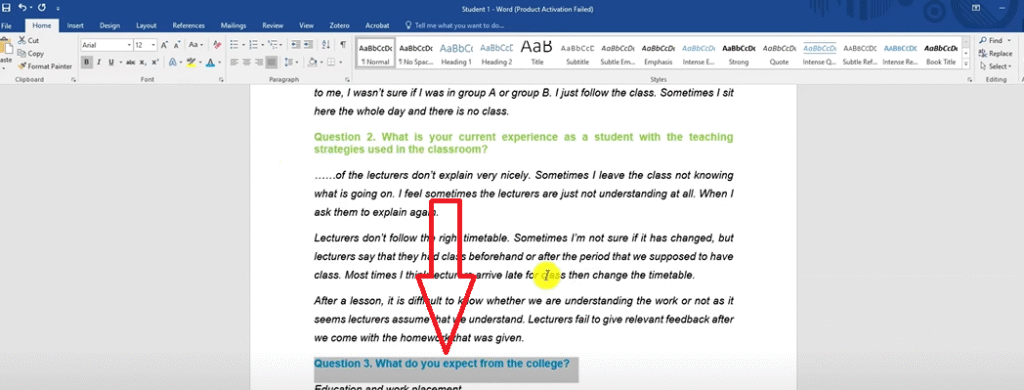
You see these are color codes for each Question.
For question four is going to be color dark purple .
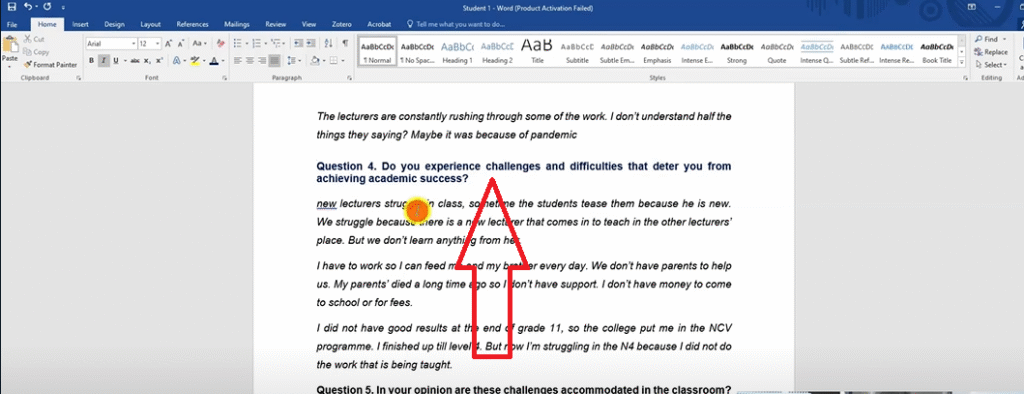
We are going to have question five as color purple.
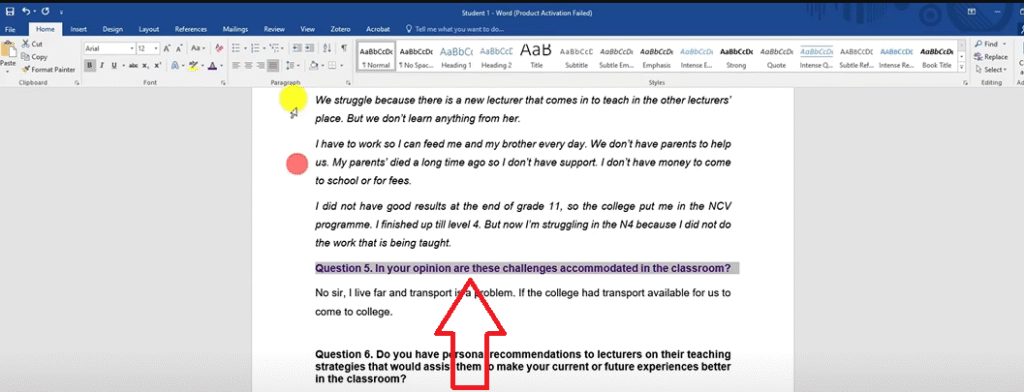
And for question six we are going to use a darker shade of yellow
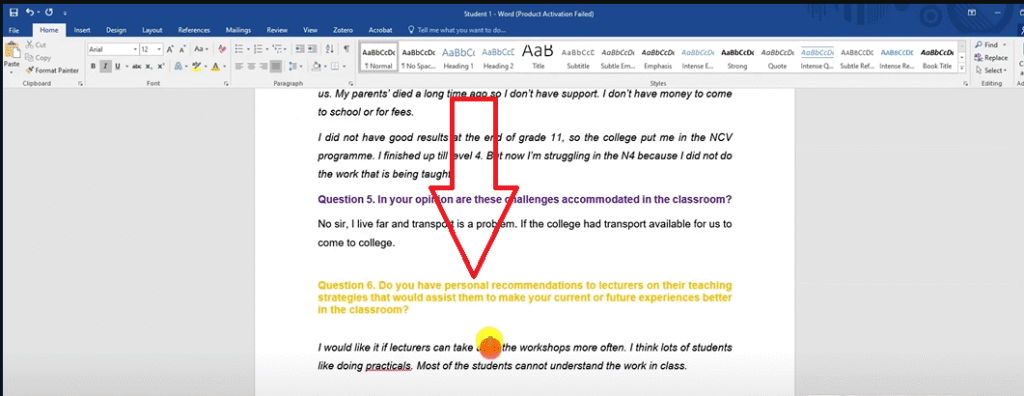
So I’m just assigning colour codes to these questions so that when we go to code In-vivo, we know the codes that came from question one we mark them as red.
By doing this we can know where the codes came from originally, which can help us when we are revising codes and combining them together to form preliminary themes in the future.
Another way is to use the question as containers.
I’ll try both ways but for completing of this work I’m going to be using question as containers.
let us start coding.
What is your experience as a student at the institution?
Let me read the whole paragraph first then I come back and continue coding.
So what is your experience as a student at the institution?
The college is nice, they make a new point job in the beginning of theyear.
They redo the roof also because it was bad here in the winter.
The classrooms leak but the toilet it’s not nice.
Toilet is always dirty yes also classrooms are not clean all the time.
But I think its students they eat in class and they leave paper.
They are on the desk on the floor.
Why at this institution must I buy textbooks? At other institutions they get textbooks for free. They get all the drawing equipment and calculator here I must pay.
Management is a problem and they don’t communicate.
The timetable is very confusing when I came here in N four, I didn’t know where I needed to be in class.
Nobody explains it to me I wasn’t sure if I was in group A or group B I just follow the class.
Sometimes I sit here the whole day and there is no class.
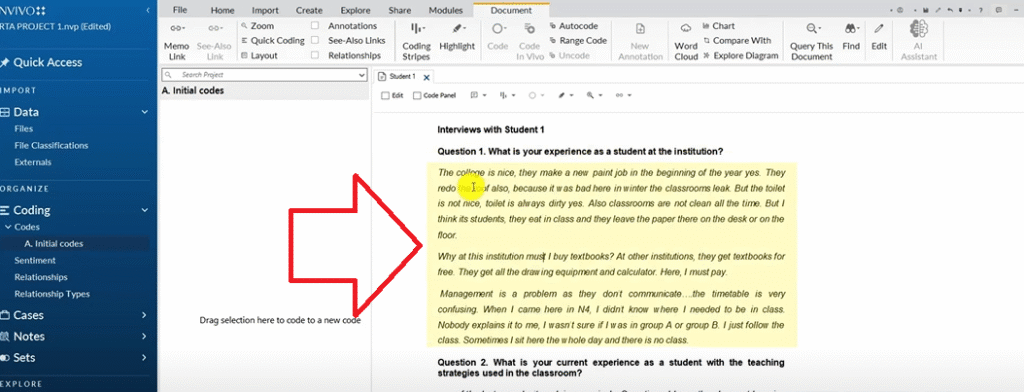
So this is the experience of students at the institution.
The college is nice they make a new paying job in the beginning of the year.
So we can code this as
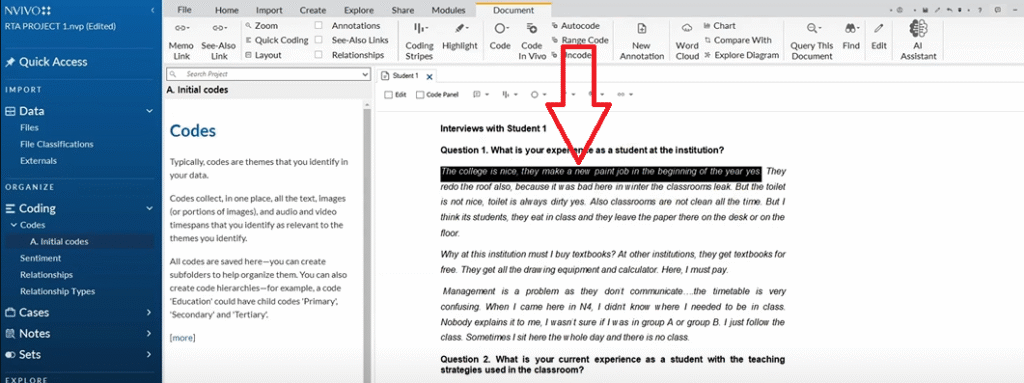
I right click I select code selection
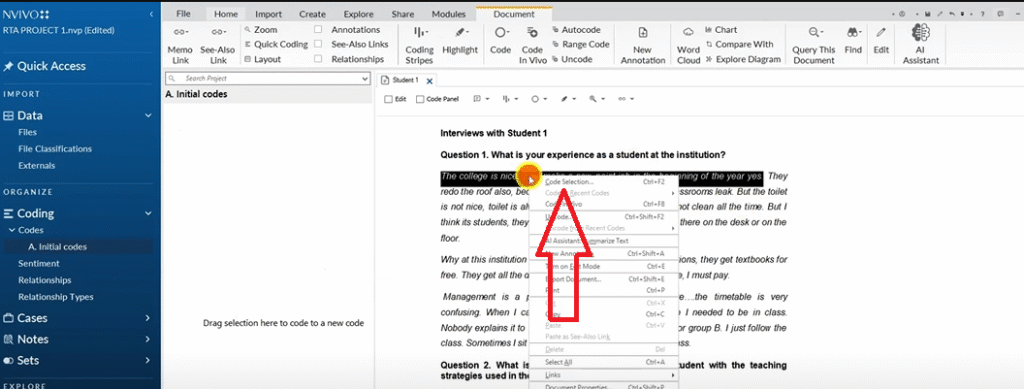
And now I go into the folder initial code.
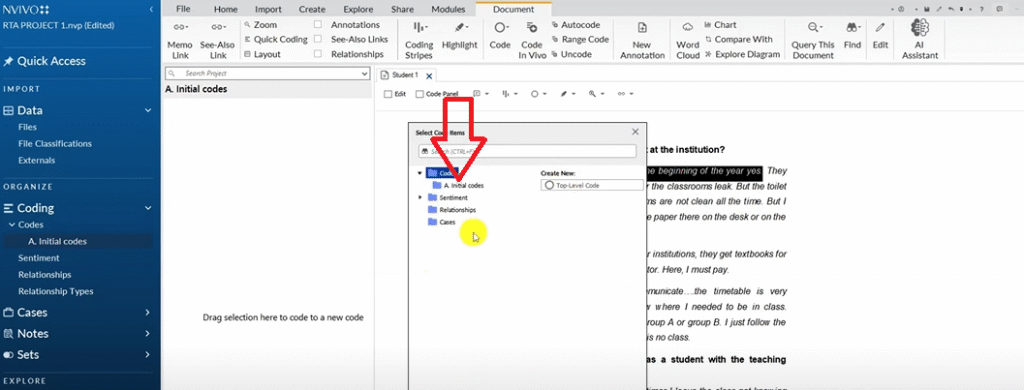
Click on top level code and say repainted classrooms.
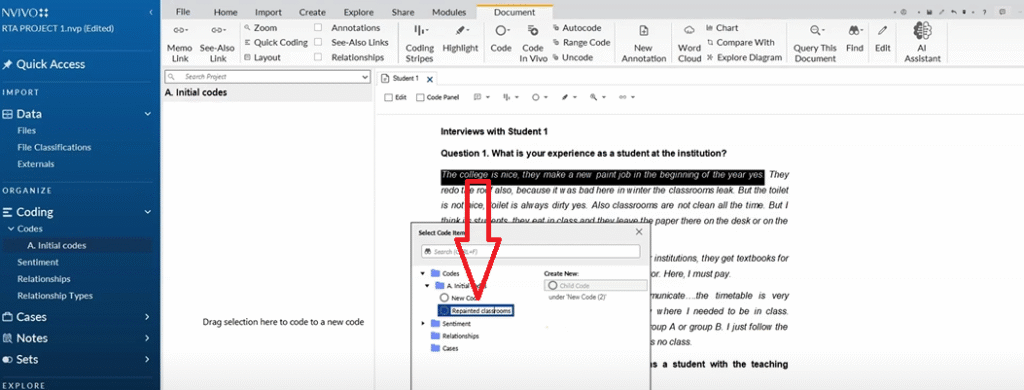
Of course this has to relate with the facilities repainted classrooms.
Then I highlight this statement they redo the roof also because it was bad here in the winter the classrooms leak, so redid or redone.
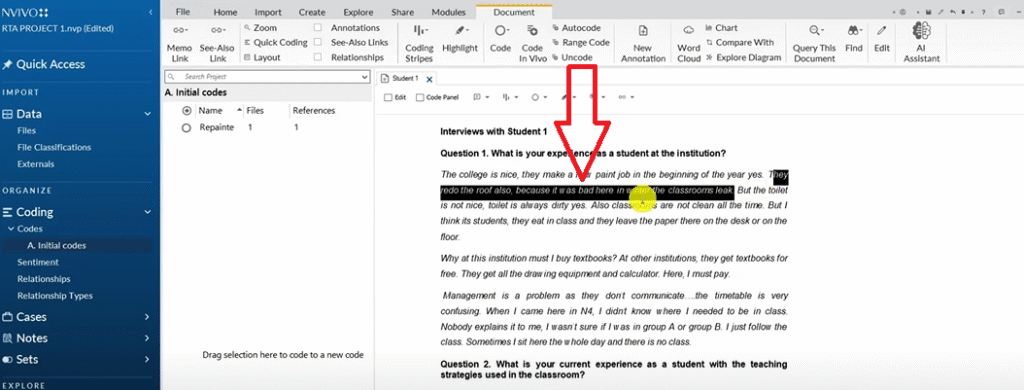
Let’s go to initial codes.
Click on top level then redone roof.
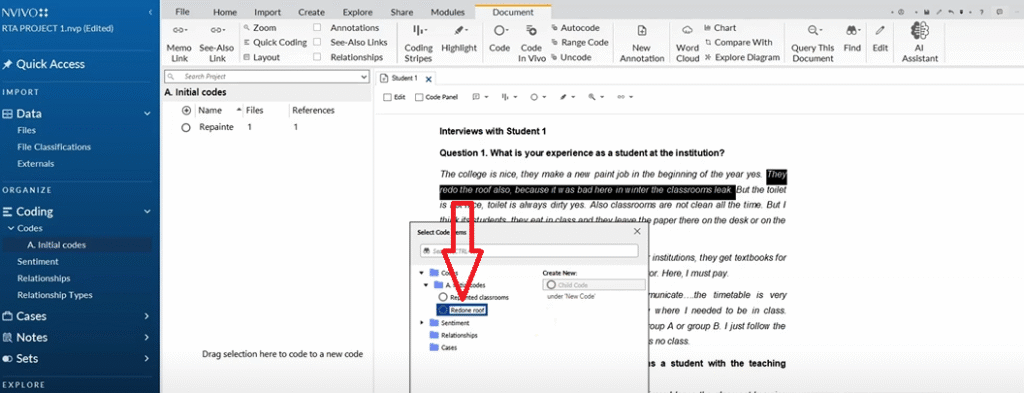
That’s another code.
Remember, I’m not obsessing all these codes and I want to close the transcript now and mark the codes with the colour red.
You remember we colour coded question one as red.
So how do I do that?
I click on the code, I go to color.
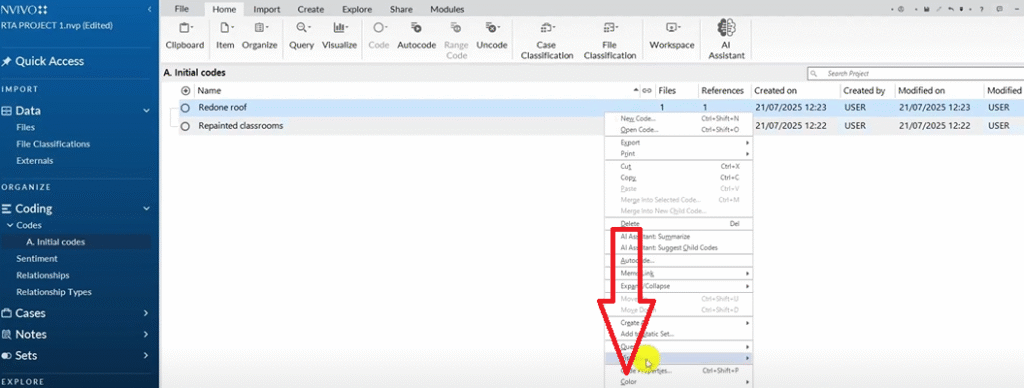
Remember red?
I click on the code, I go to colour. Remember red?
So you look here on the edge on my right, you’ll see that code is red.
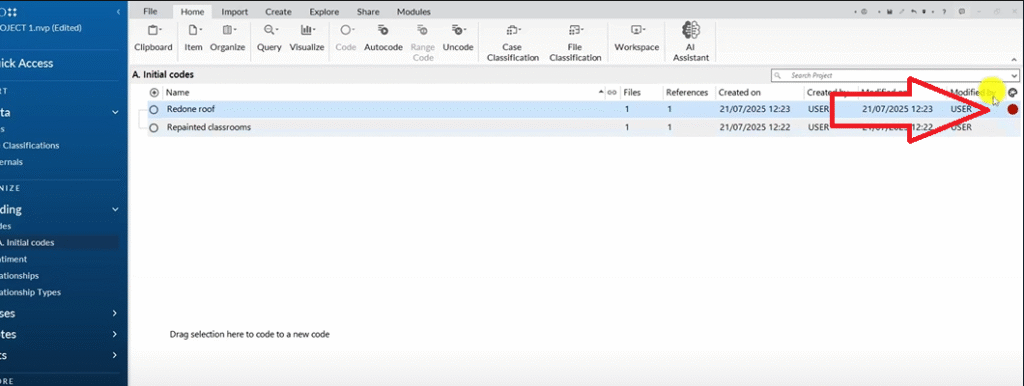
So I know it came from question one.
I can redo another one and colour red.
That is one way of capturing this.
So let’s see the experiences.
Also the classrooms are not clean all the time, so dirty classrooms.
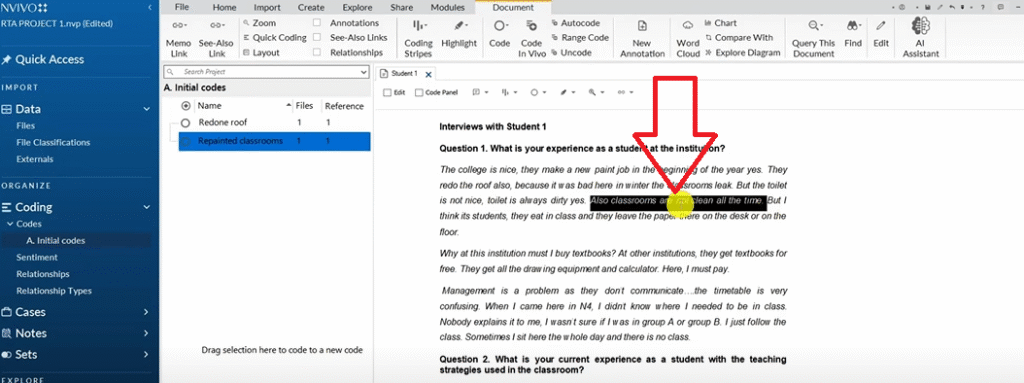
Right click code selection click on initial code.
top level code and say.
dirty classrooms.
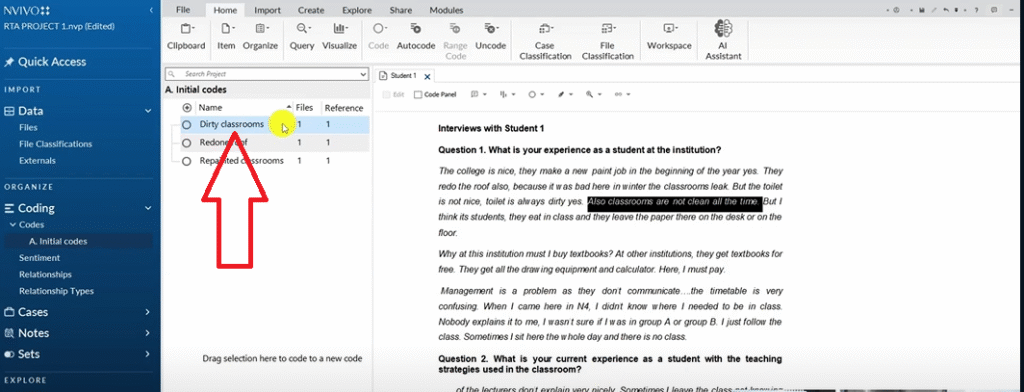
we have to right click and select colour red or mark that code as coming from question one which we gave or we assigned the colour code red.
But I think the students they eat in class and they leave paper on the desk or on the floor why at these institution must I buy textbooks at other institutions they get textbooks for free they get all drawing equipment and calculator here I must pay.
So let’s highlight this as
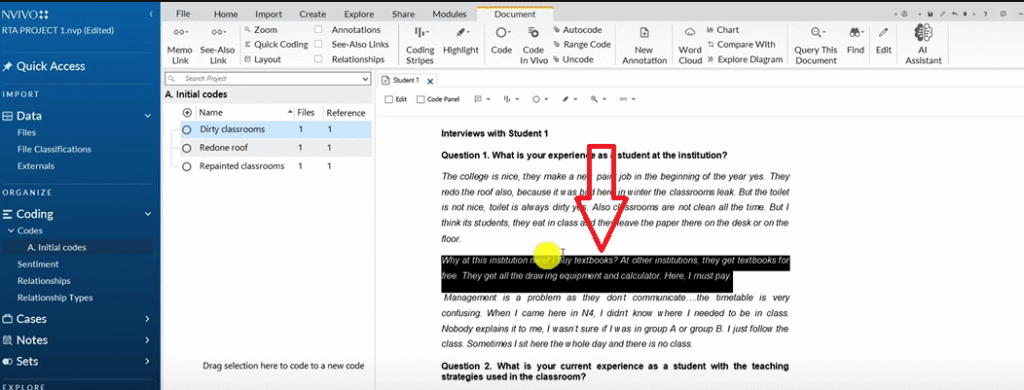
Needing to pay for learning resources.
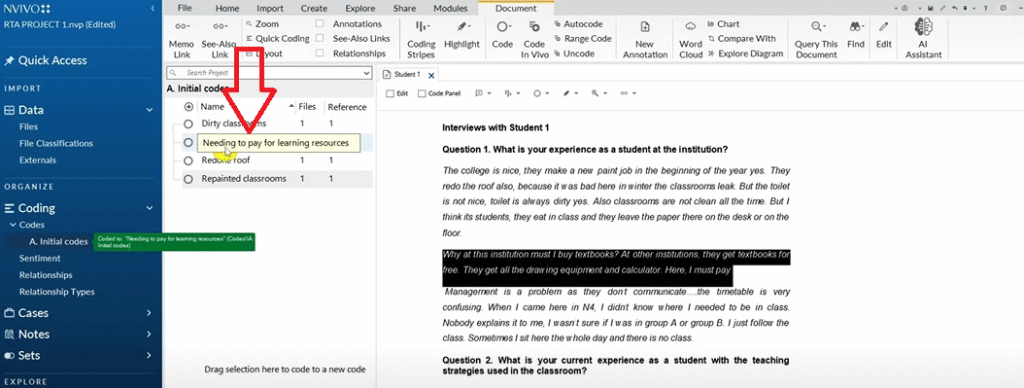
Look at that code it’s not three words like the others but it’s still an accurate code.
So that’s an experience needing to pay for learning resources.
Probably a negative experience, but we get back to that later.
Then management is a problem and they don’t communicate.
The time table is very confusing when I came here in N four, I didn’t know where I needed to be in class nobody explained it to me.
I was sure I was in Group A or Group E I just followed the class sometimes I sit here the whole day and there is no class.
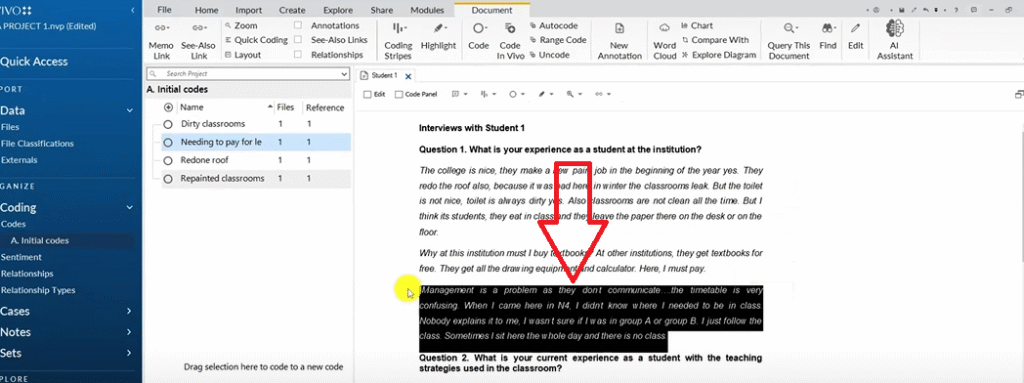
So let’s right click that whole paragraph, go to initial codes and highlight these as poor communication from the management.
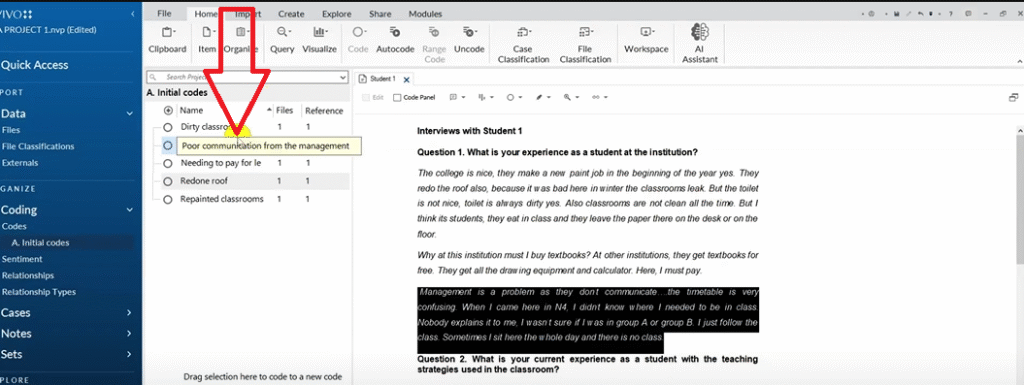
So that’s how I add the code.
For that code right click, go to color mark it as red.

I want to show you another approach of knowing where the codes came from and this approach we use questions as containers.
I click on initial codes.
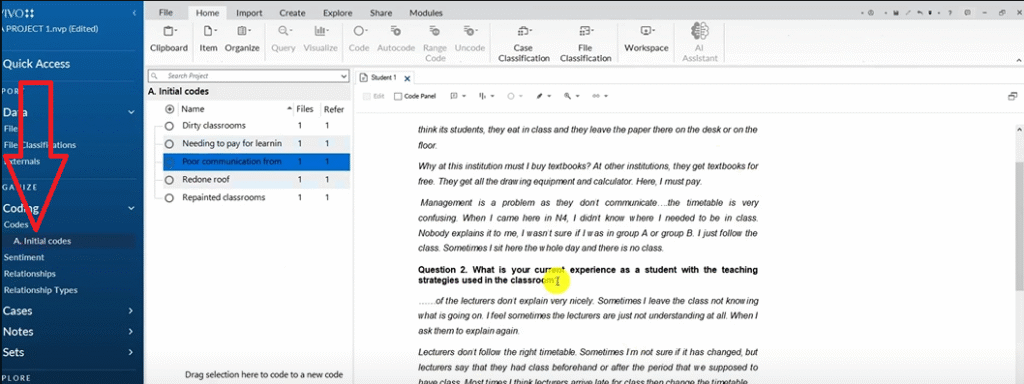
I go and copy this question.

Then I go to the blank space.
Right click, click on new code.
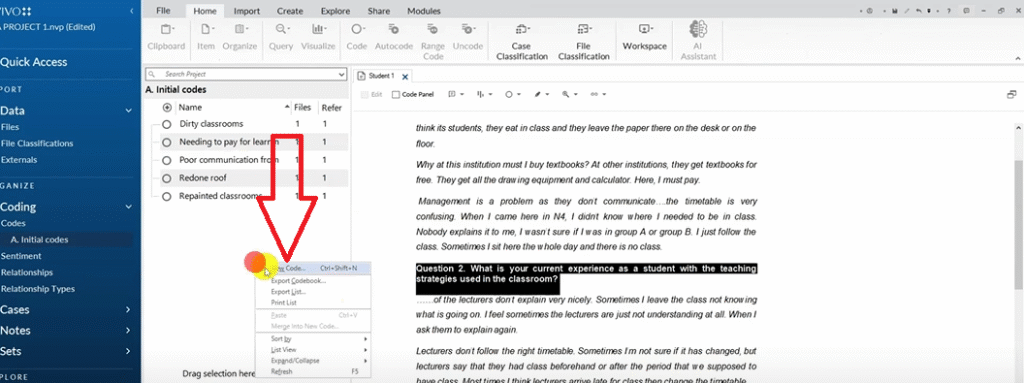
Then I paste this question, delete the question mark.
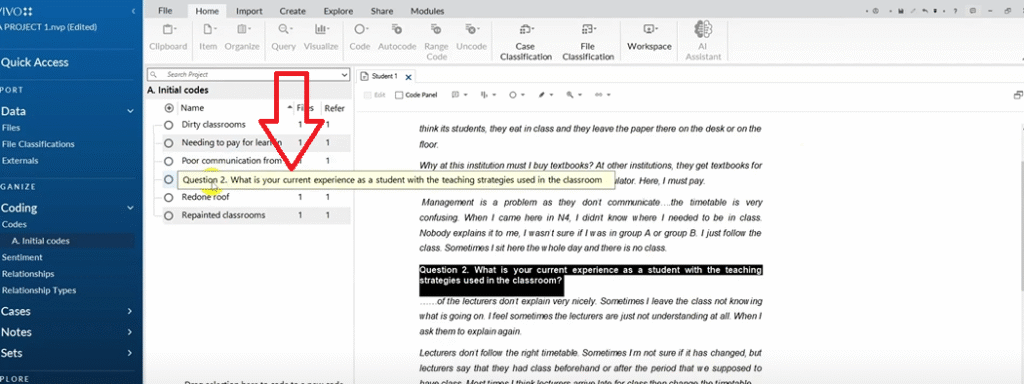
You see this question two, this question is not a code, it’s a container.
Take it like a bucket where we are going to put the codes.
The first approach is using colour codes.
The second approach is using questions as containers.
Let’s code and you’ll see what I’m trying to do.
What is your current experience as a student in the teaching strategies used in the classroom?
Let’s read the whole thing then we come back and code.
The lecturers don’t explain very nicely sometimes I leave class not knowing what is going on.
I feel sometimes the lecturers are not just understanding at all when they ask to explain.
Again lecturers don’t follow the right timetable.
Sometimes I’m not sure if it has changed but lecturers say that they had class beforehand or after the period that they were supposed to have class.
Most times I think lecturers arrive late to class then change the timetable.
After a lesson, it’s difficult to know whether we are understanding the work or not as it seems.
lecturers assume that we understand lecturers fail to give relevant feedback after we come with homework that was given.
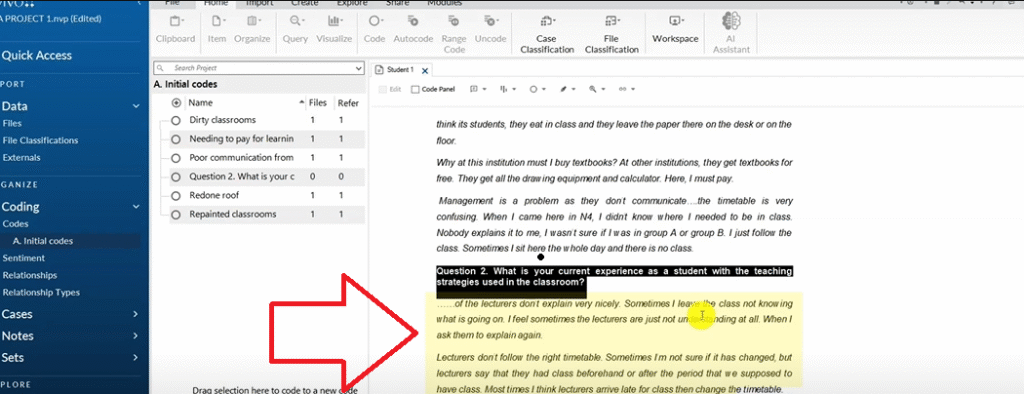
So let’s just now code this.
What is your current experience as a student with the teaching strategies used in the classroom?
The lecturers don’t explain very nicely sometimes I leave class not knowing what’s going on.
I feel sometimes the lecturers are just not understanding at all, when I ask them to explain again.
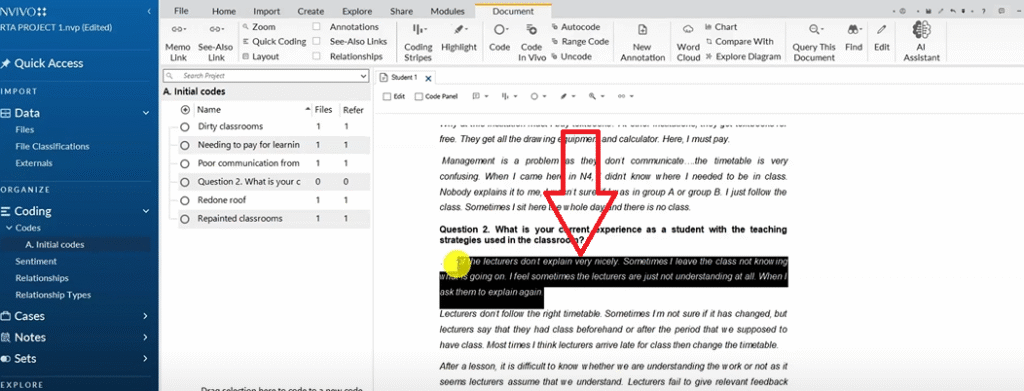
So the current experience as a student is I right click.
Click on code selection.
Remember now click on question two.
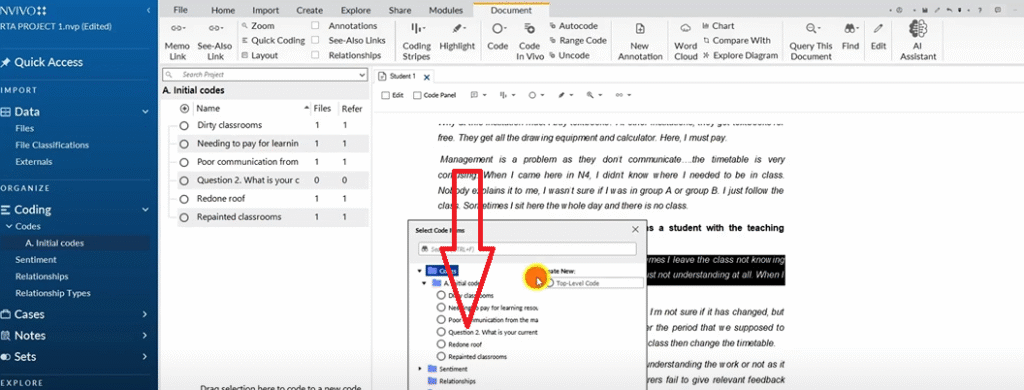
I want to put a child code, I click on child code.
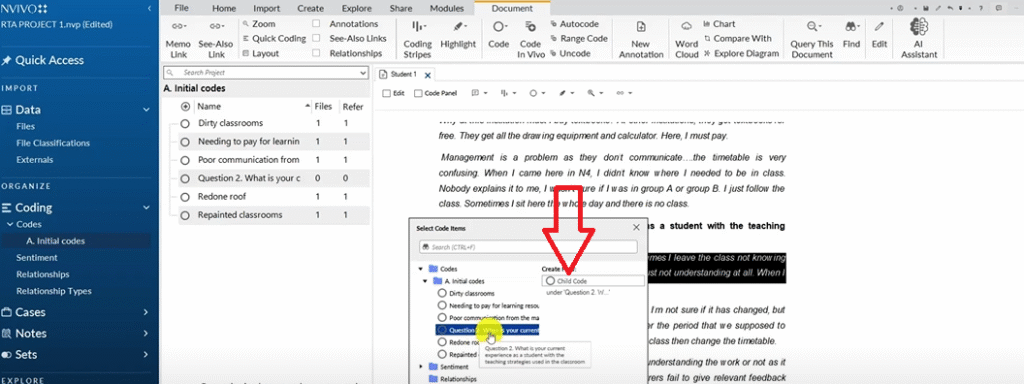
Inadequate explanation from the lecturers.
That code will come under question two if you click on the plus sign.
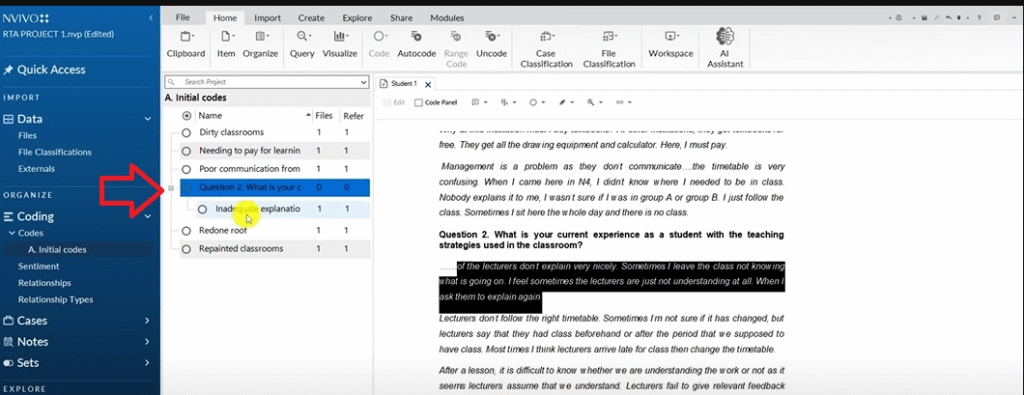
By the way, if I double click on that code you can see the exact quote where that code came from.
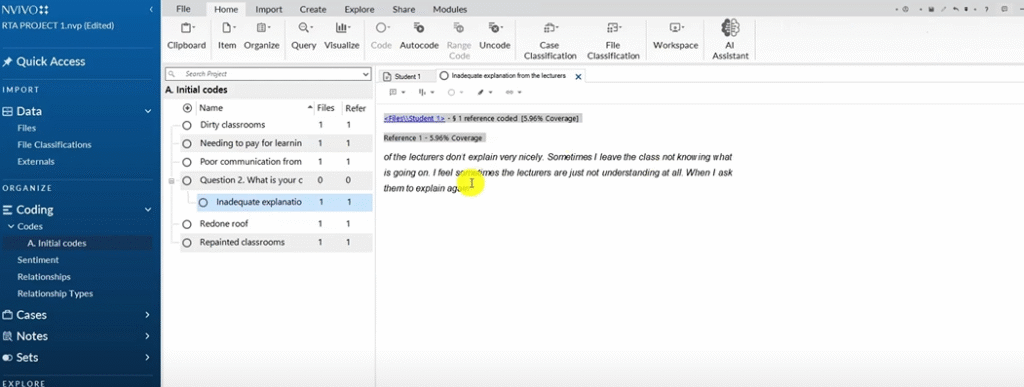
This is what we just coded from student one, Inadequate explanations from the lecturers
So that’s one experience of this person.
Then lecturers do not follow the right timetables sometimes I’m not sure if it has changed but lecturers say they had a class beforehand or the period that they were supposed to have class most of the times I think lecturers arrive late for class then change the timetable.
So let’s select that.
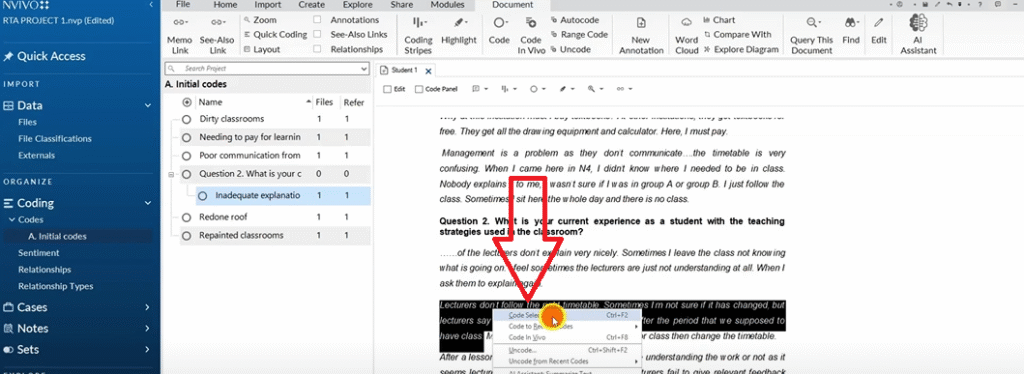
Go to question two.
Click on child code.
And say arriving late for class or do not follow the timetable.
let’s save this you see this is the message I was telling you that will prompt us to save every 15 minutes, let’s say Yes.
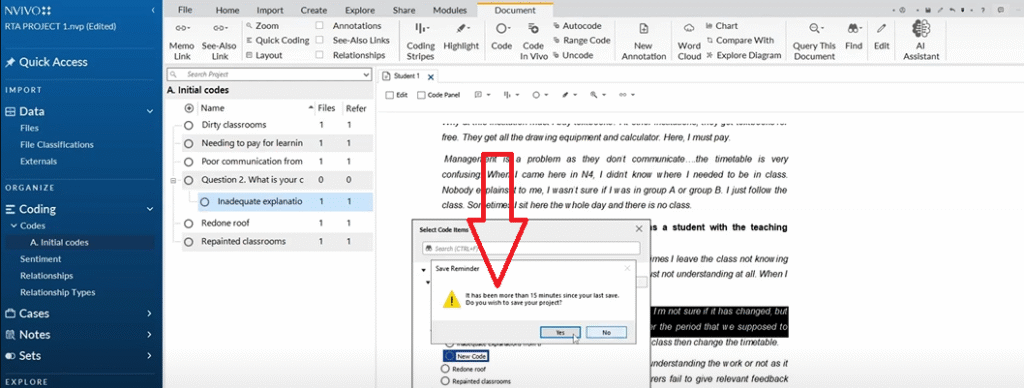
So let’s keep coding.
Lecturers struggle to adhere to the timetable
so they struggle to adhere to the timetable.
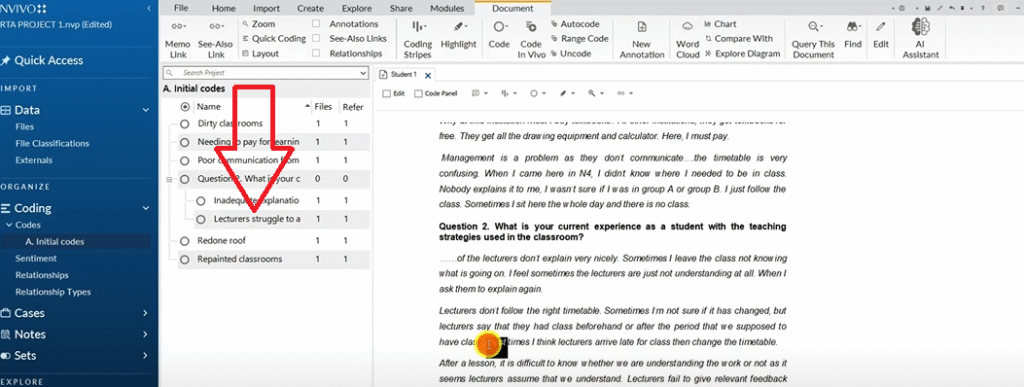
I want to also code this second statement.
Most of the times, I think lecturers arrive late for class and change timetable, so they believe that lecturers are not punctual.
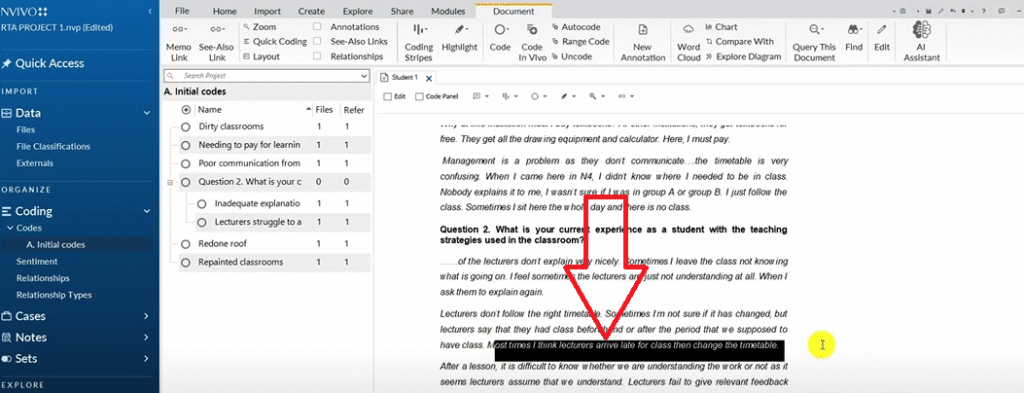
Remember, we can code different statements in one paragraph with different codes.
That’s what I’m going to do so I click code selection.
New child code.
I’ll say lecturers lack punctuality.
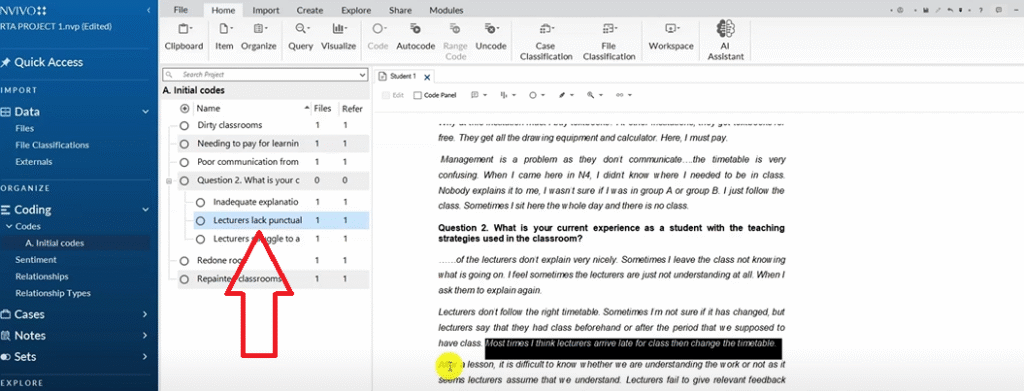
Let’s keep coding
After a lesson it is difficult to know whether we are understanding the work or not.
As it seems, lecturers assume that we understand.
Lecturers fail to give relevant feedback after we come with homework that was given.
I want to just highlight this last statement and say.
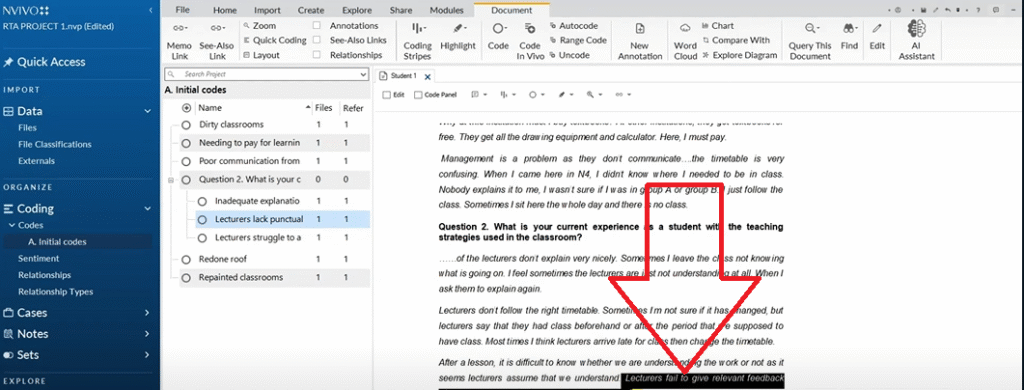
lecturers not providing sufficient feedback on assignments.
That’s it.
So all the codes are under question two, I put them under question two.
Then if I right click.
Select aggregate coding from children.

Look at the numbers, they were zero.
Now files one and references four.

that means that we have coded files from a single participant four references
Let’s go back to question one and redo it based on questions as containers ’cause that’s the approach I want to use.
I don’t want to use colour codes.
So I go and I copy that question.

Go to the initial codes.
Click in the blank space, Select and paste the new question.
Delete the question mark, click okay.
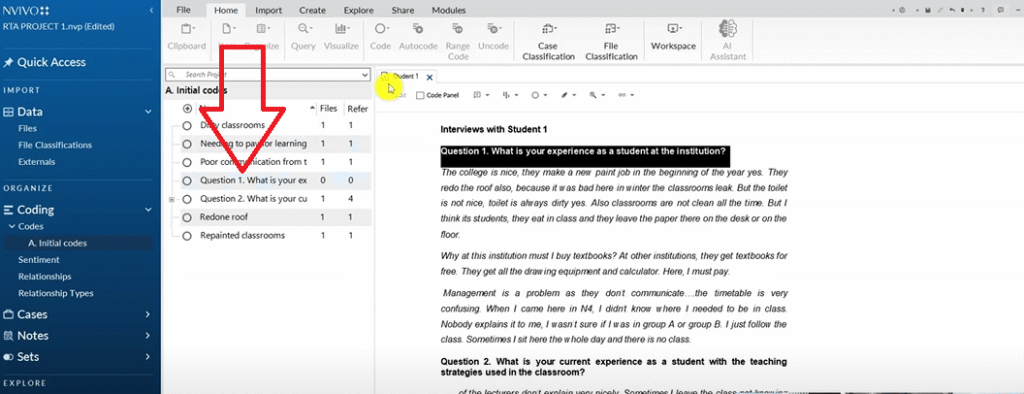
Then I select the five codes that came from question one and drag and drop them inside question one.
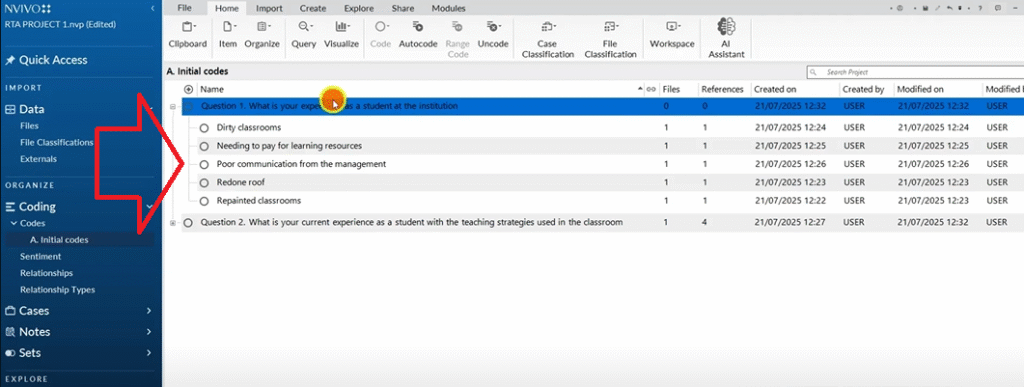
Then I right click, I go to aggregate coding from children.

You see, that’s how we do it, that’s how we handle this kind of work.
Normally I use question as containers not to influence meaning but to just know where the codes came from initially.
so that later I can go and combine codes to form preliminary themes, but we’ll come to generating themes, which is the third step of reflexive thematic analysis later.
For now, let’s go and just code the second transcript, I am coding the first and second question so that you understand the hang of it.
Click on that transcript.
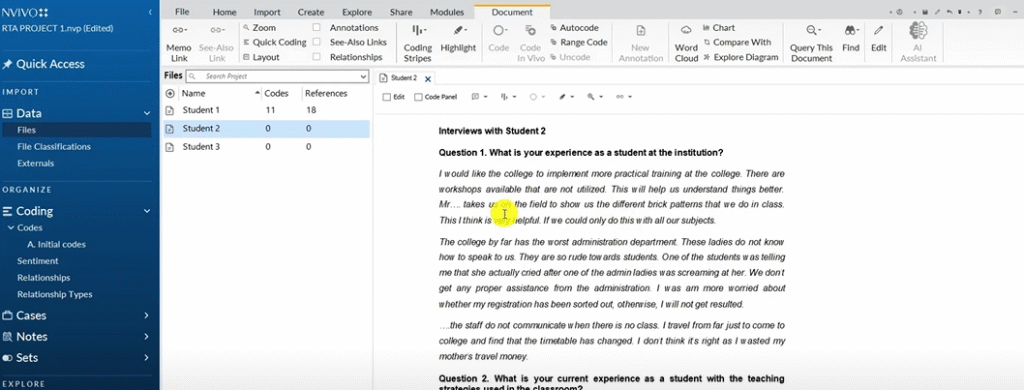
Let’s go to question one, of course the codes that we are going to get from the second transcript will still be put under Question one. So let’s do this.
What’s your experience as a student at the institution?
Again, I like reading the whole thing then I come back and code.
I would like the college to implement more practical training.
There are actions available that are not utilized this will help us understand things better
Mr…. takes us on the field to show us different brick patterns that we do in class.
I think this very helpful if we could only do this with all our subjects.
The college by far has the worst administration department.
These ladies not know how to speak to us.
They’re so rude towards the students, one student was telling me that she actually cried after one of the admin ladies was screaming at her.
We don’t get any proper assistance from the administration.
I’m more worried about whether the registration will be sorted out, otherwise I will not get result.
The staff do not communicate when there is no class, I travel from just to come to college and find the timetable has changed.
I don’t think it is right as I wasted my travel money.
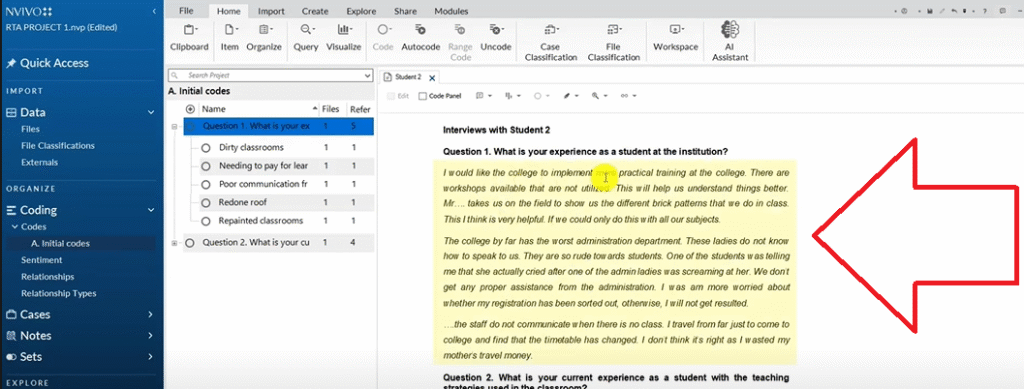
So what’s your experience as a student in the institution?
I would like the college to implement more practical training.
So this whole paragraph I highlight it.
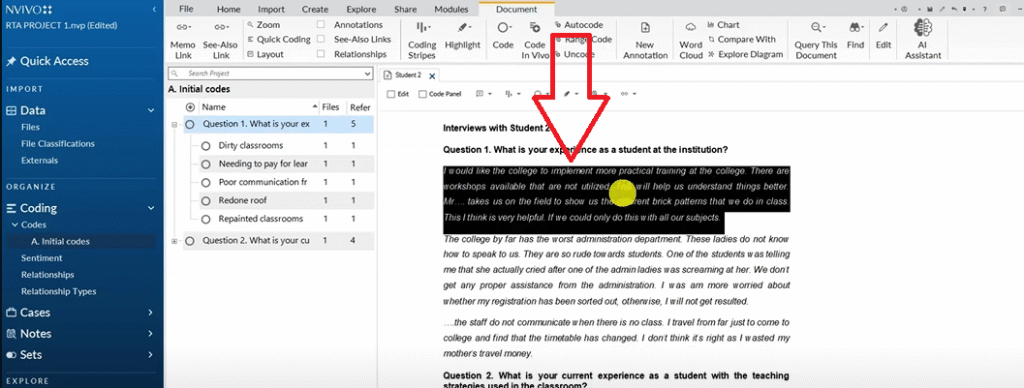
Then I go to code selection.
Go to question one.
Lack of sufficient practical training in the college.
You can see that code was assigned under question one.
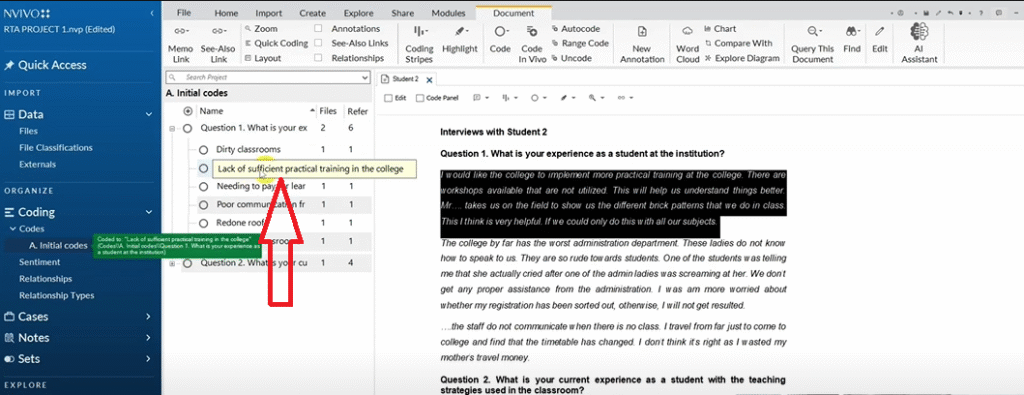
Then the college has by far the worst administration.
This ladies do not know how to speak to us.
They are so rude toward students. One student was telling me that she actually cried after one of the admin ladies was screaming at her.
if i highlight that.
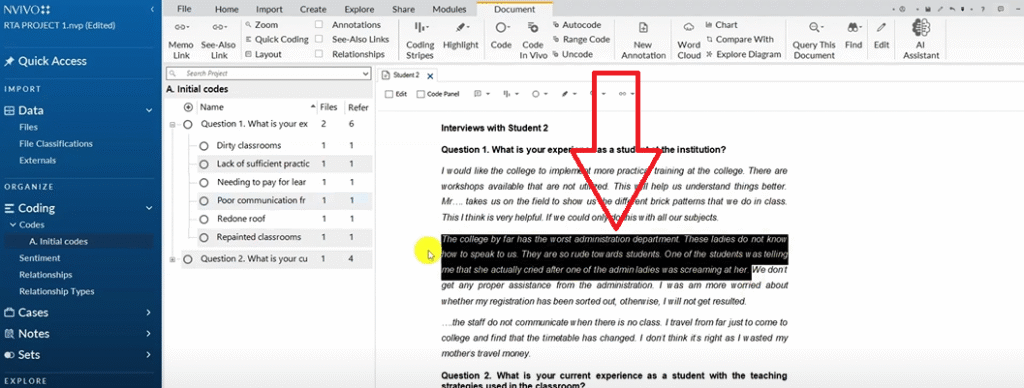
And you remember we had a code called Poor communication from the management.
This emphasizes that from another participant.
How do I handle this?
I can drag and drop this under the code because they say the same thing.
That quote says exactly the same thing Poor communication from the management.
Look now two files or two quotes let me double click so that you can see what I mean.
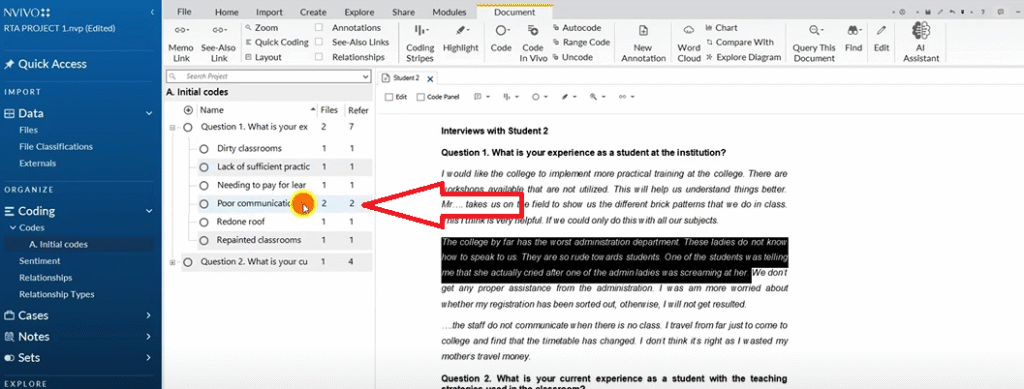
This code now is supported by two students with two different codes that say exactly the same thing.
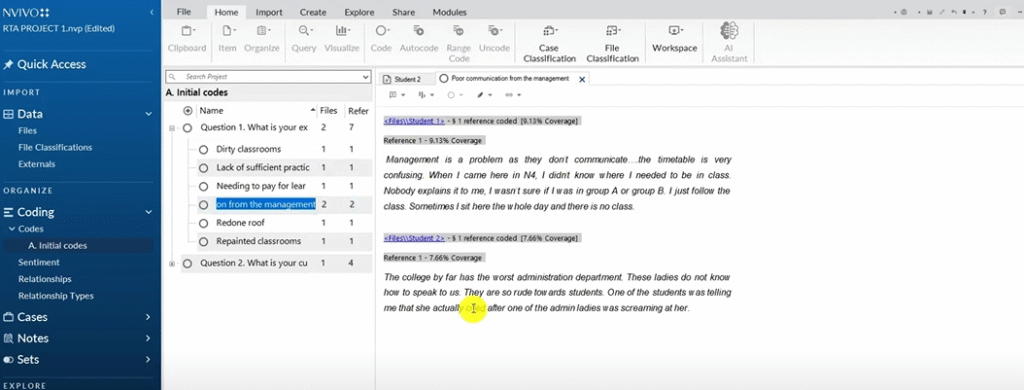
That’s where two files and two references came from.
The staff do not communicate when there is no class.
There was also poor communication from the staff.
so I highlight this one.
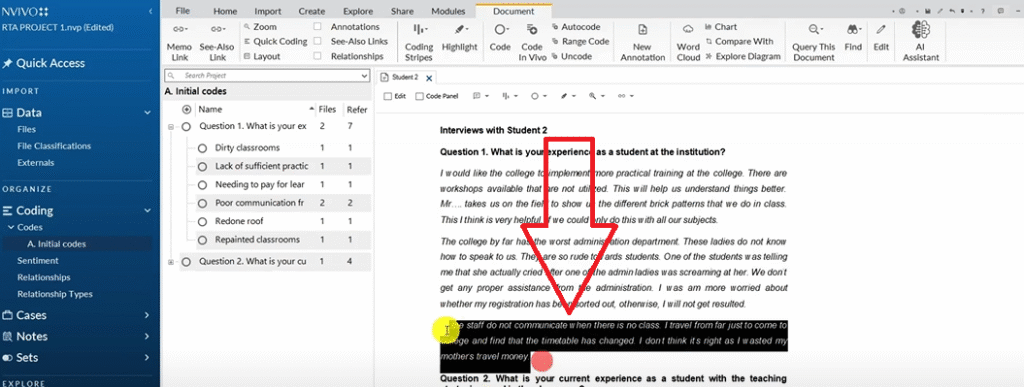
Let me code this as a new code, we can combine it later and call this, click on question one.
Click on child code and say poor communication from the staff.
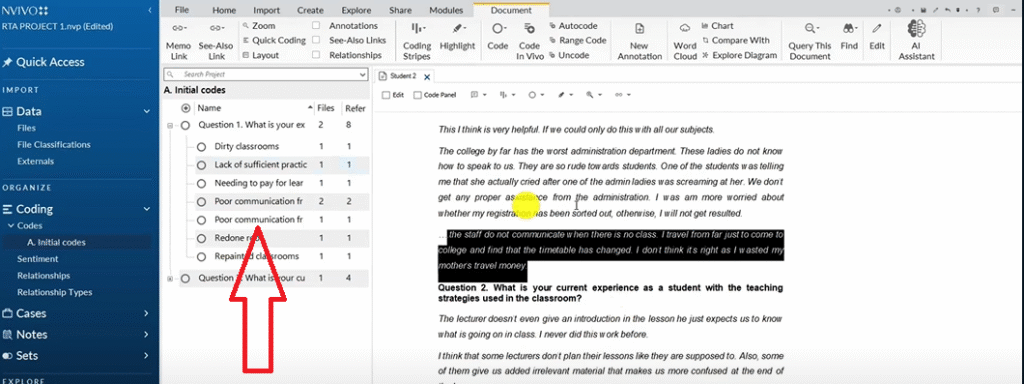
Then
what is your current experience as a student with the teaching strategies used in a classroom?
The lecturer doesn’t even give an introduction with the lesson, he just expects us to know what is going on in class.
I never did this work before, they provide inadequate explanation.
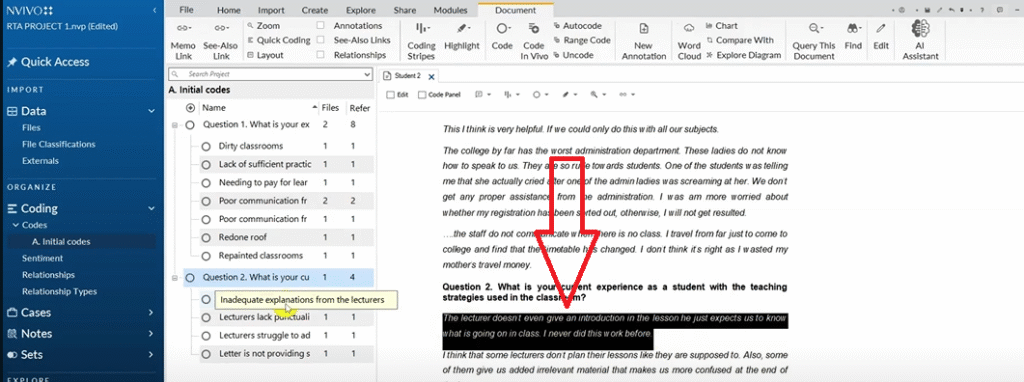
I think there is a code that goes with that, so I drag and drop that quote in there.
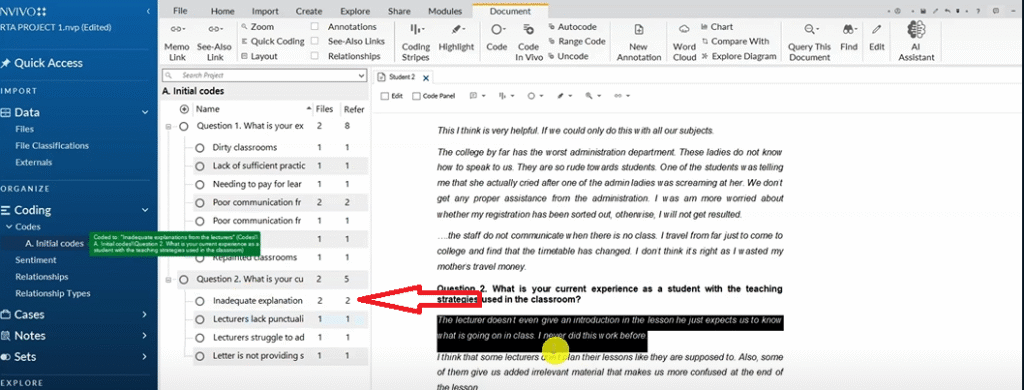
You see the numbers change.
I think some lecturers don’t plan their lessons like they’re supposed to.
Also, they give us added irrelevant material that make us confused at the end of the lesson.
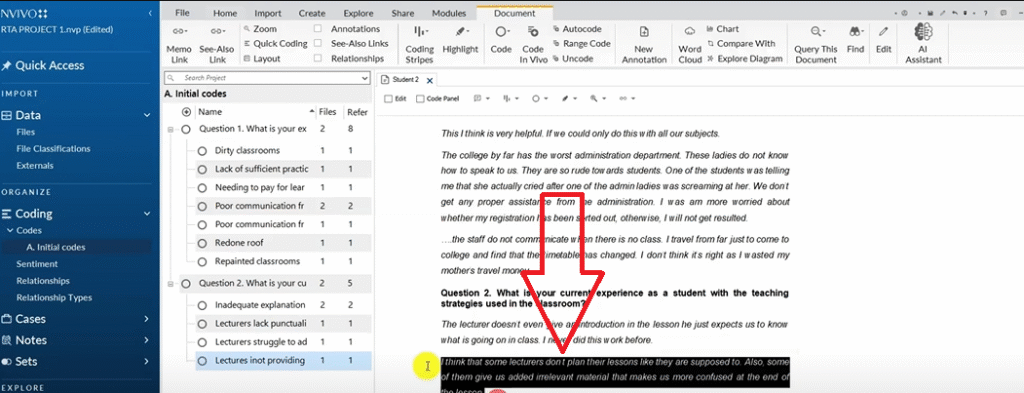
So let’s say this is under question two, click on Child code insufficient planning from the lecturers.
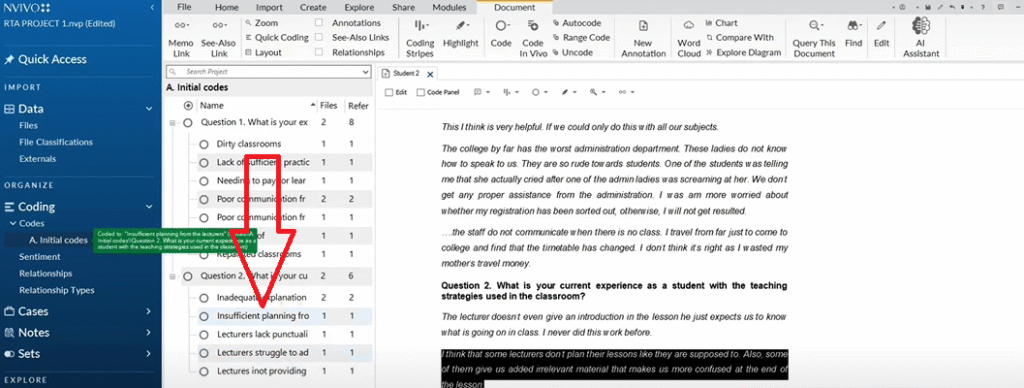
I think some lecturers don’t plan their lessons like they’re supposed to.
Also, they give us added irrelevant material that make us confused at the end of the lesson.
So let’s say this is under question two, click on Child code insufficient planning from the lecturers.
then lecturers do not give us time to wrap our heads around what has been taught.
They just immediately start with the next module or chapter, I think students must be allowed space to think and consume the knowledge that are been given to us.
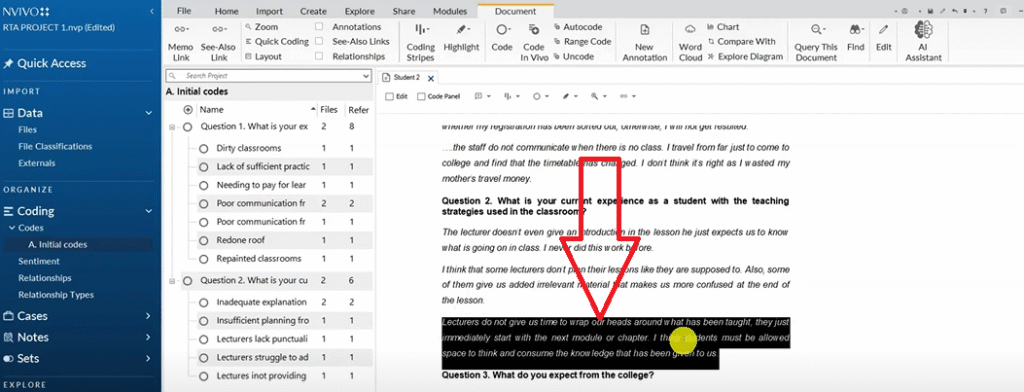
so
lecturers not giving students sufficient time to digest what they have been taught.
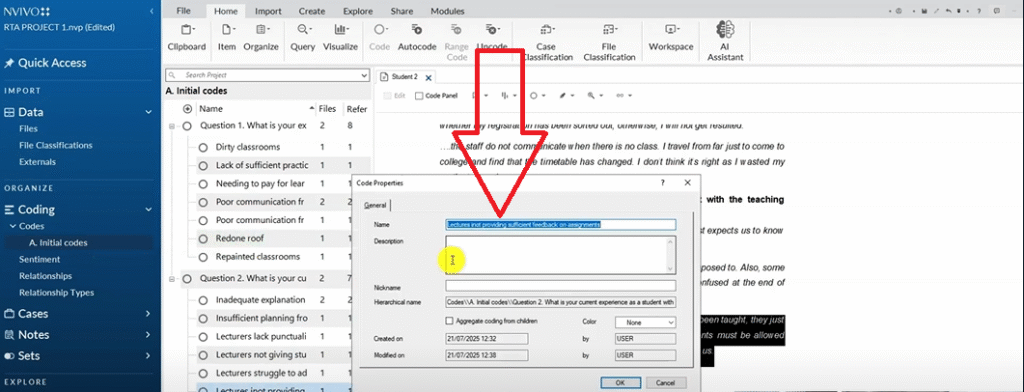
You can see that’s a very long code, but these codes, we always go and edit them and revise them.
You can see how I’ve coded for two transcripts.
And now for the first question, you can see I have two files, eight references.
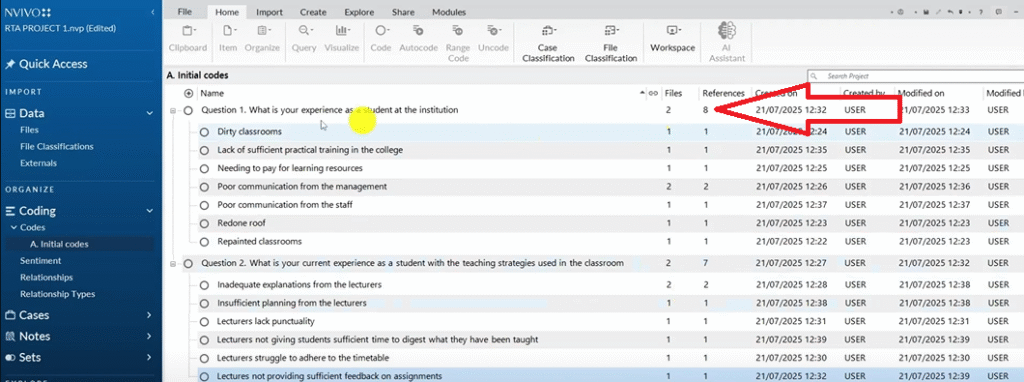
The second two files, seven references.
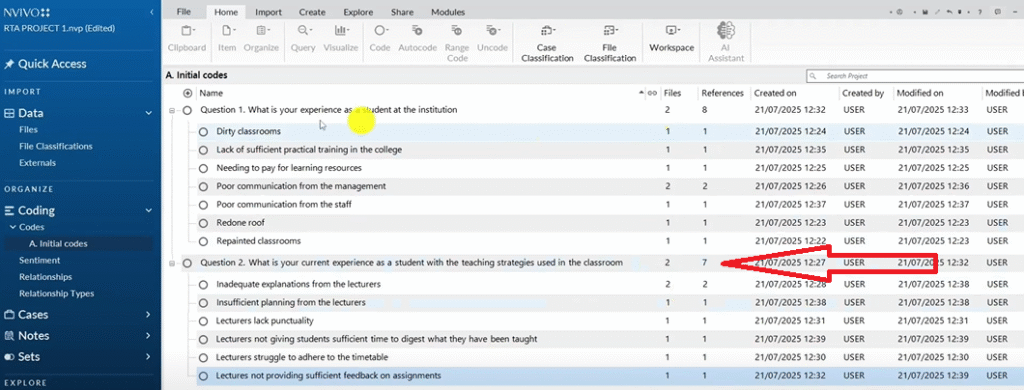
So that’s how we conduct the second step of reflexive, thematic analysis by Braun and Clarke, which is generating initial codes.
Then after this step there’s another step which is not included in Braun and Clarke but I think it’s very important.
What I normally do I’ll go to codes.
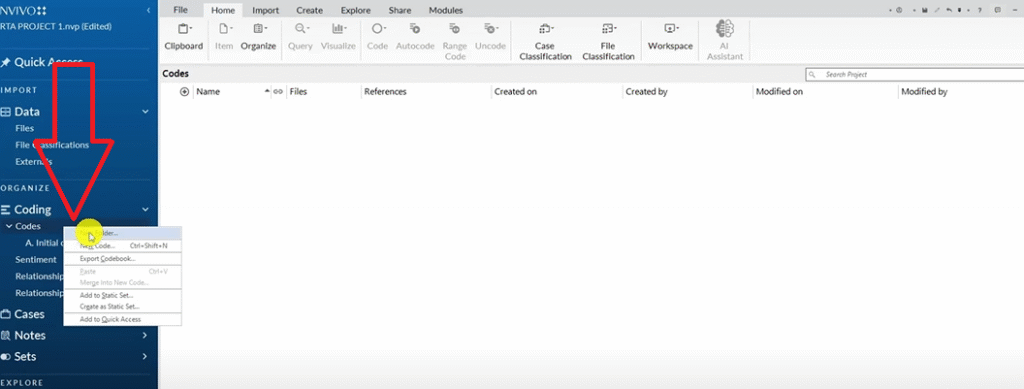
Create a new folder, call this B, Revised codes
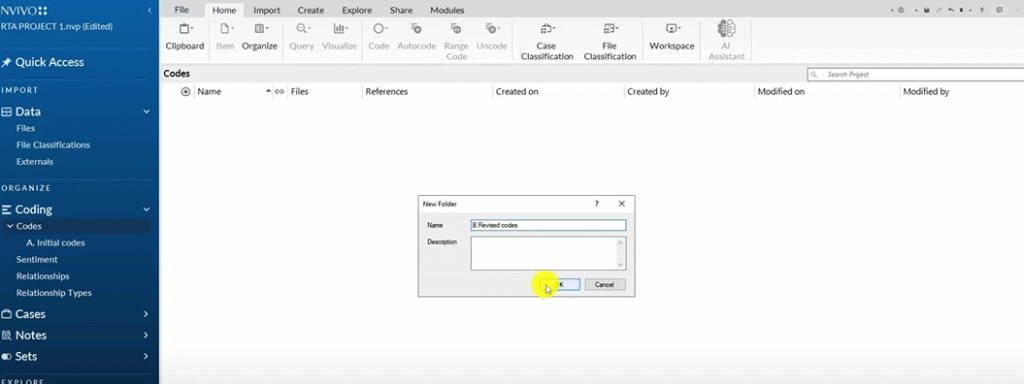
I normally revise my codes.
So now I want to revise my codes.
I go and copy these two codes from the question by clicking on control A.
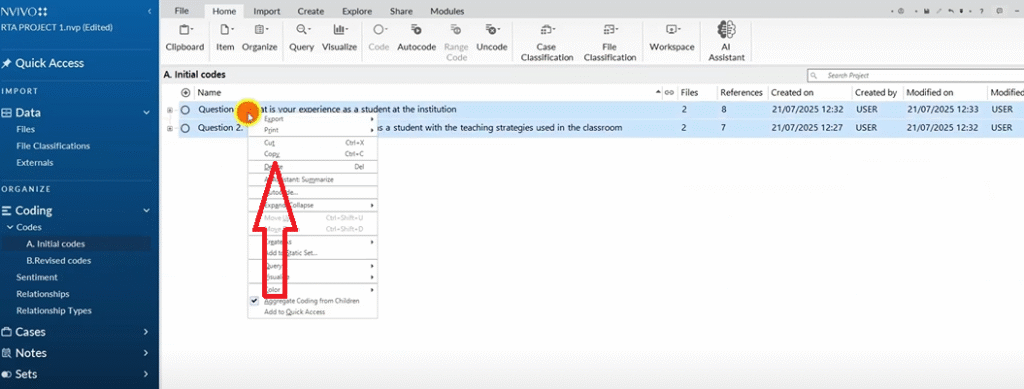
Then I go to revised codes I click on paste..
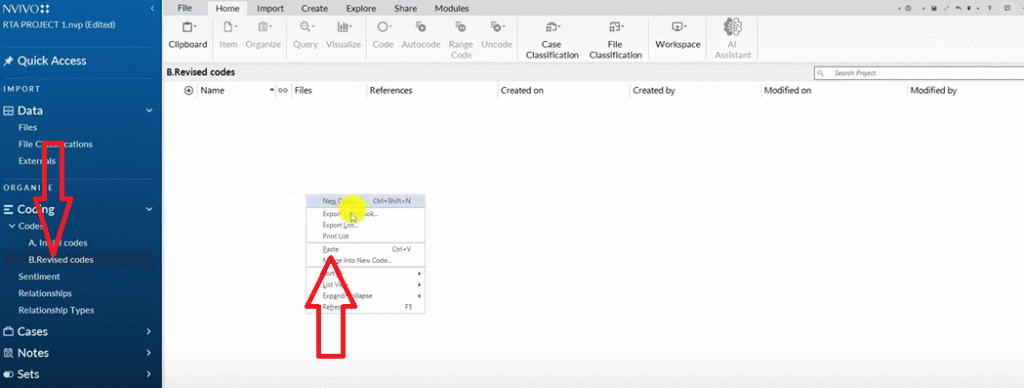
So that’s how I duplicate the work.
I don’t edit the main or the primary folder.
This is the second folder which I am editing.
Now let’s go and look at the codes by revising codes, we just double click on the codes to see or we read the code and then code again.
Then we ask ourselves do I need to make this code sound better? For example, that classrooms, also classrooms are not clean all the time I think that’s a good code.
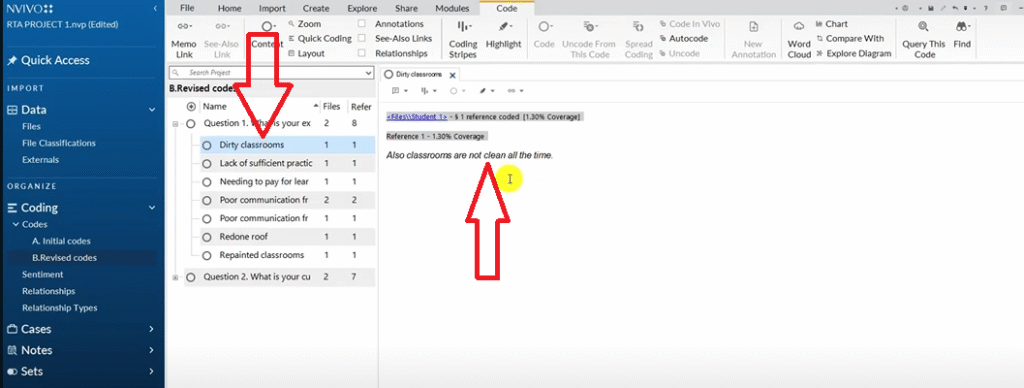
Lack of sufficient practical training in the college.
So if I double click on that, there is a lack of sufficient practical training.
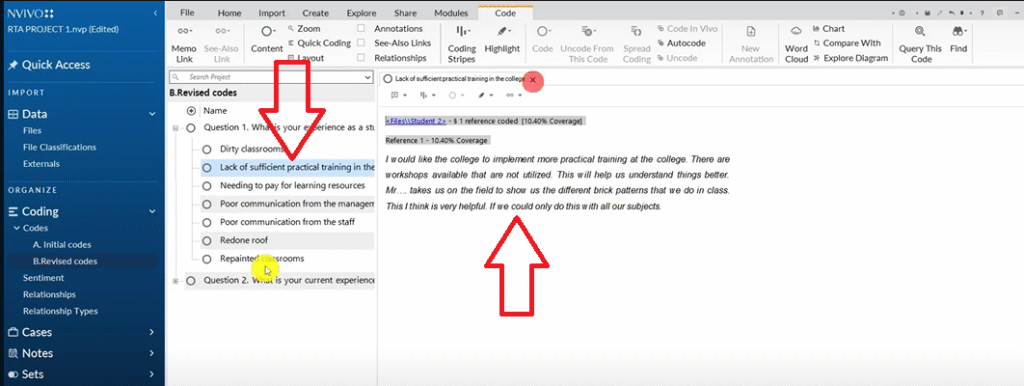
So we go and check code by code, then we revise them
After revising codes now we are ready to move to the third step of the Braun and Clarke which is generating initial themes.
This step of the reflective thematic analysis by Braun and Clarke we develop themes.
Generating initial themes, revising themes and adding descriptions
So I want to go to and create a new folder called Preliminary themes.
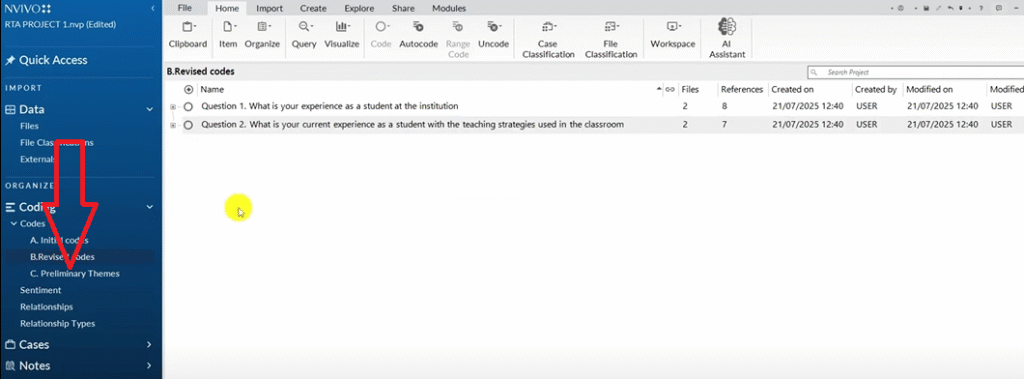
When you have preliminary themes folder how do we proceed?
We go to the revised codes, I’m assuming we have revised our codes, which I have not done because of purposes of making the video a bit shorter.
Now press control A, right click and press on copy.
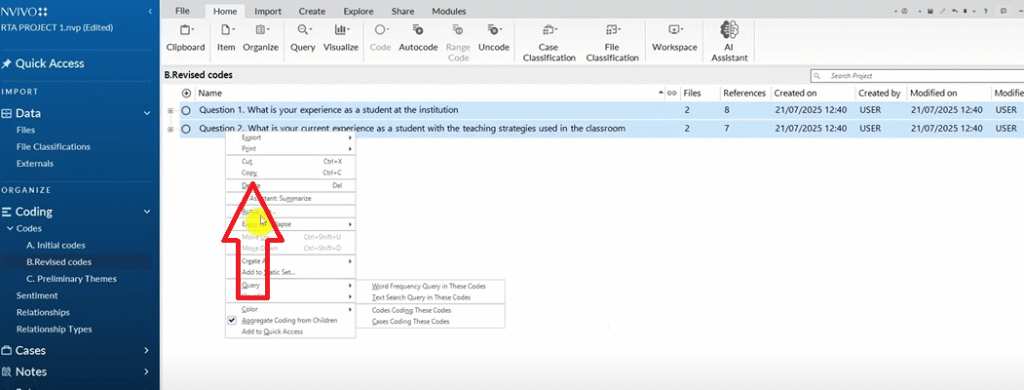
Then go to the preliminary themes folder which I just created and paste.
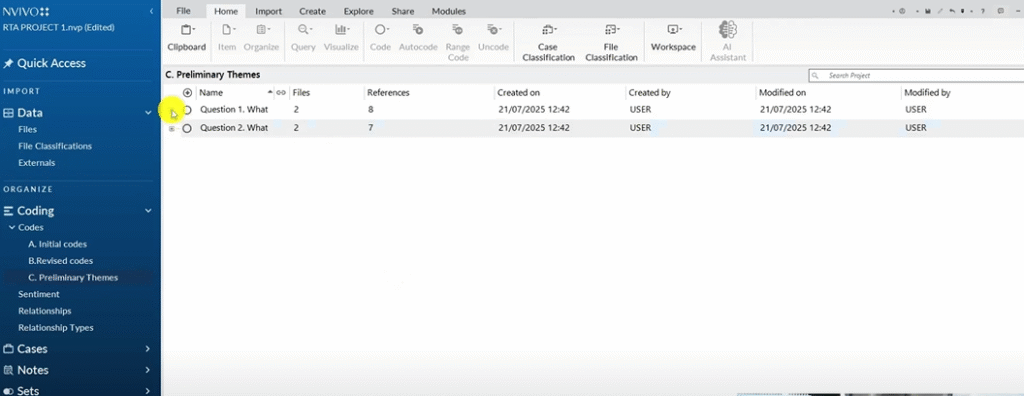
Now we are going to edit, look at the codes, forget the questions but we can consider what was being asked.
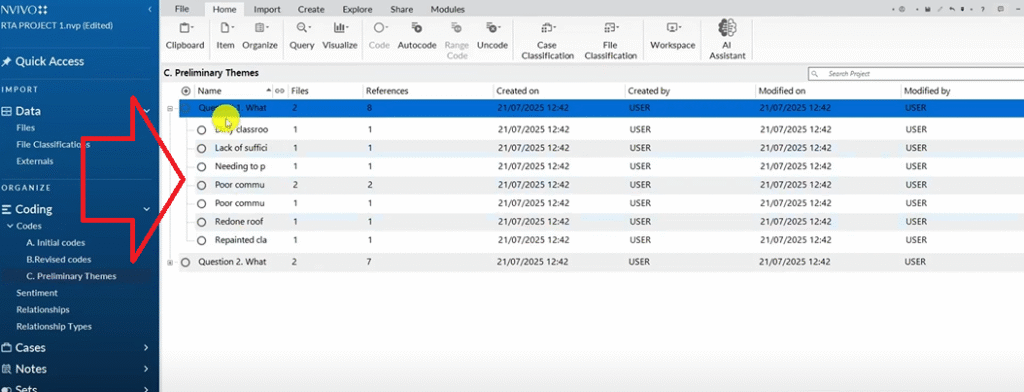
What is your experience as a student in the institution?
If you look at what the students are saying?
Poor communication.
Poor communication from the staff.
poor communication from the management.
Redone roof.
repainted classrooms.
So if you look at this what are these?
Let’s go and right click and go to code properties.
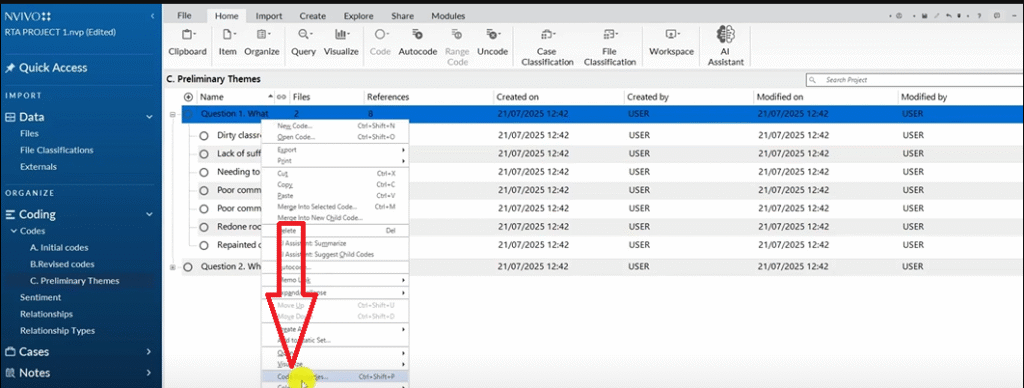
And I want now to call this theme one, not a question.
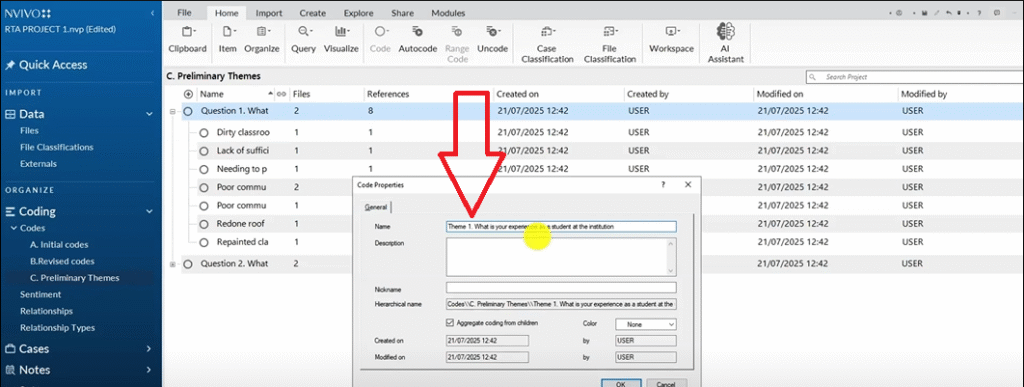
And now I want to edit this according to the meaning or combined meaning based on the question.
what is your experience as a student in the institution?
I want to call this
student experiences at the institution.
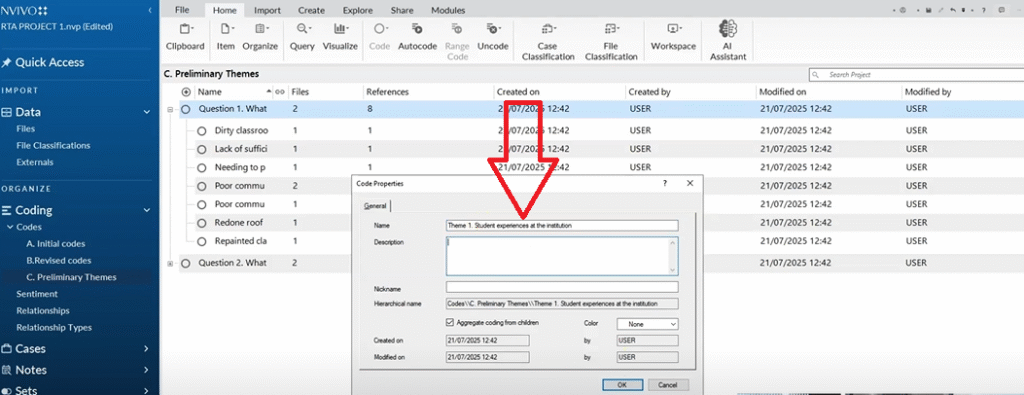
Then I want to write a description for this theme.
This theme represents both positive and negative experiences of students at the college institution.
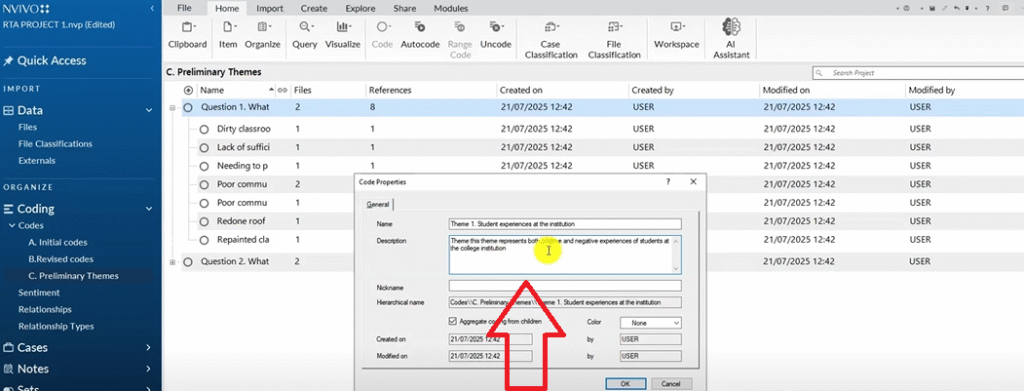
Now if you look at the codes, look at a code called redone roof, repainted classrooms poor communication, poor communication, needing to pay for learning resources, lack of sufficient practical training and dirty classrooms.
You can see there is a contrasting, Redone roof and repainted classrooms are examples of positive experiences.
So how do I add what we call a sub theme which is based on shared meaning of the code.
So I right click in the blank space and then I go and create this, we call sub theme I positive experiences.
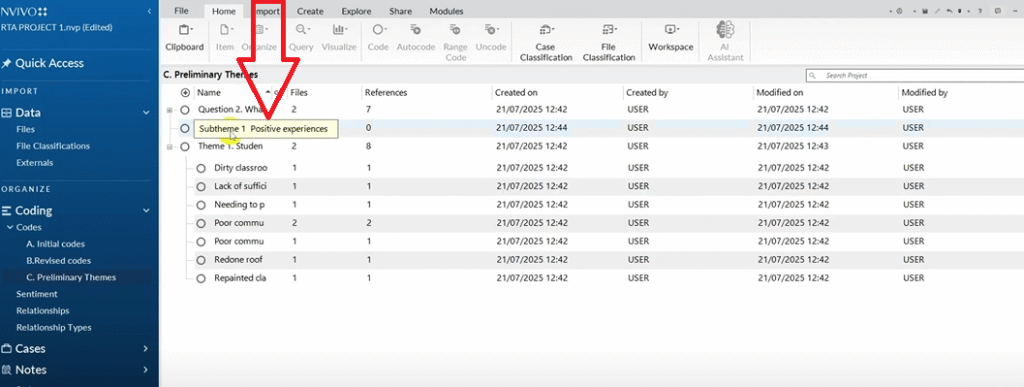
So I drag and drop that inside Question one.
You see this is the sub theme.
Then I drag and drop the codes under that sub theme.
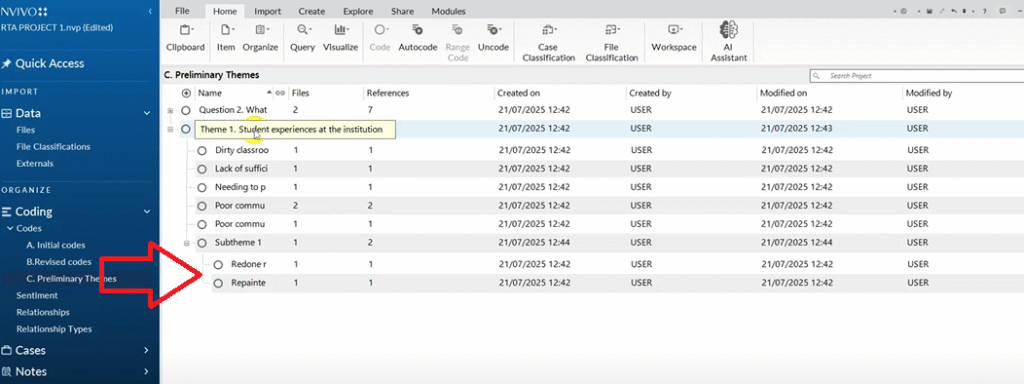
Those are positive experiences, remember we are looking at student experiences in the college at the institution so positive experiences and now let’s create another new code.
So I right click in the blank space.
Sub theme two.
Then I call this negative experiences.
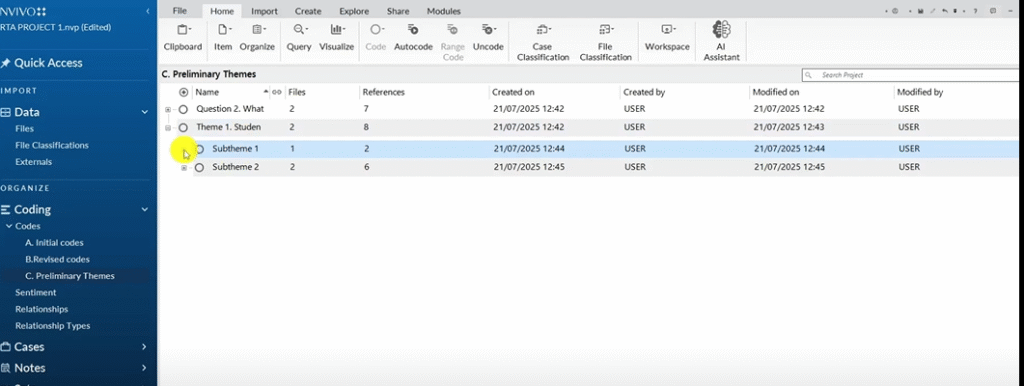
I drag and drop that sub theme under question one.
Then all negative experiences of the student I select all those codes,
Then I drag and drop them under Sub theme two.
Then I right click and aggregate coding from children.
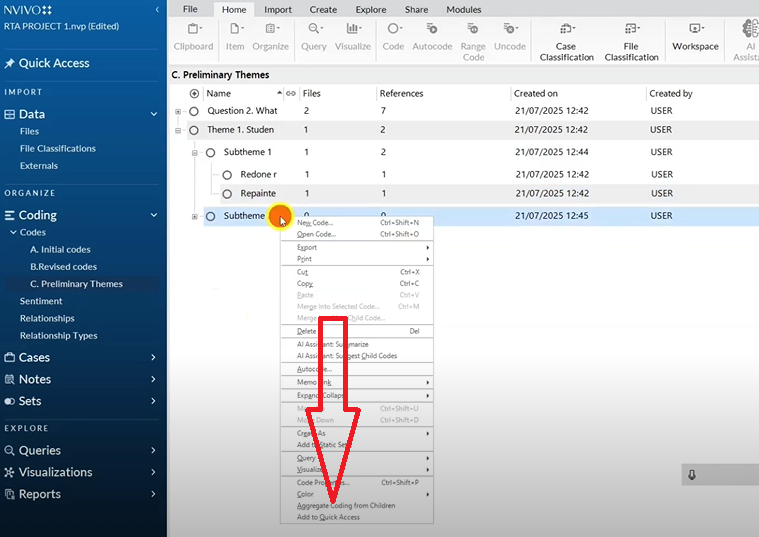
This is how we start moving from questions to themes and sub themes by looking for a pattern of shared meaning across our initial codes or across our codes.
Look at these negative experiences.
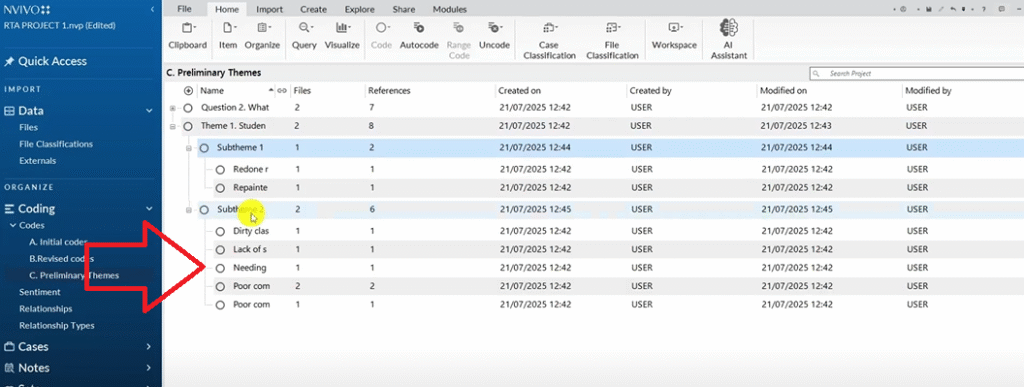
And I can describe here.
So I right click code properties.

Then say this sub theme represents the negative experiences of students at the institution.
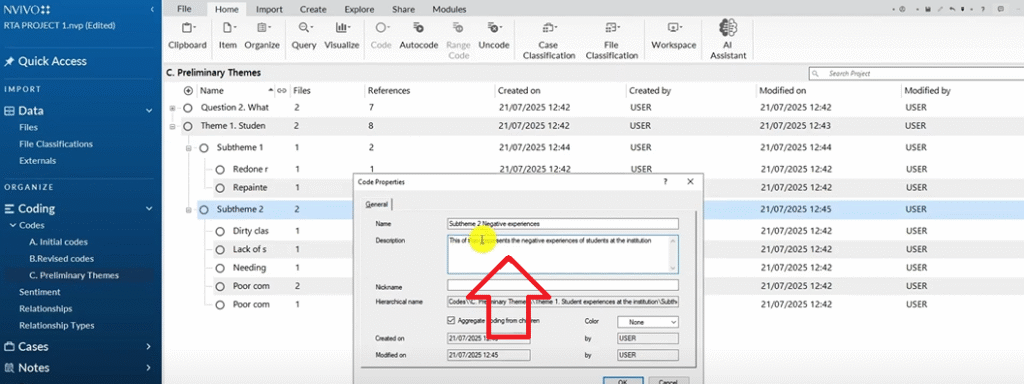
This is how we go to the third step of generating themes from codes using the reflexive thematic analysis approach by Braun and Clarke.
I want also to go to sub theme one and highlight this, go to Code Properties and write a description this Sub theme represents the positive experiences of students in the institution.
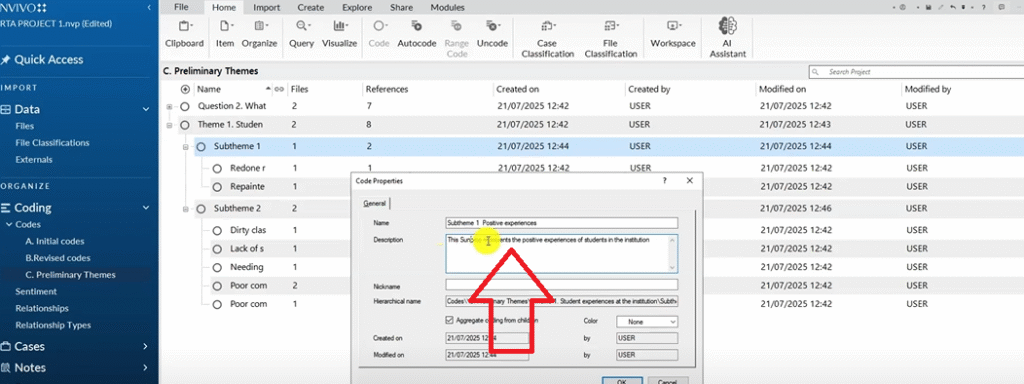
Now look at that.
We have a theme and two sub themes, this is the process of forming Preliminary themes and trying to review.
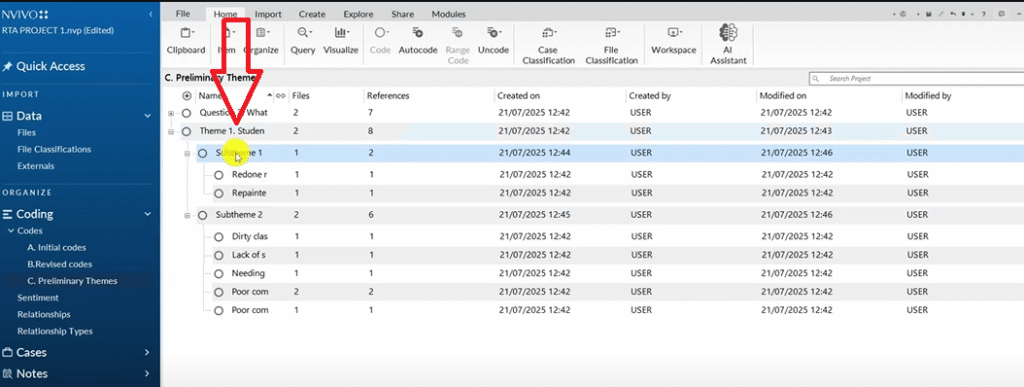
Although here I’m doing even the other step or the fourth step of the Braun Clarke which is reviewing and refining themes.
I think I’m doing these three steps of Braun and Clarke together.
I’m generating themes.
I’m reviewing and refining the themes.
And I’m providing clear description
Basically, I’m doing these steps together because I don’t want to forget what these themes mean.
So that’s how we get sub themes.
I want also to go to question two, what is your current experience as a student with the teaching strategies using in a used in the classroom?
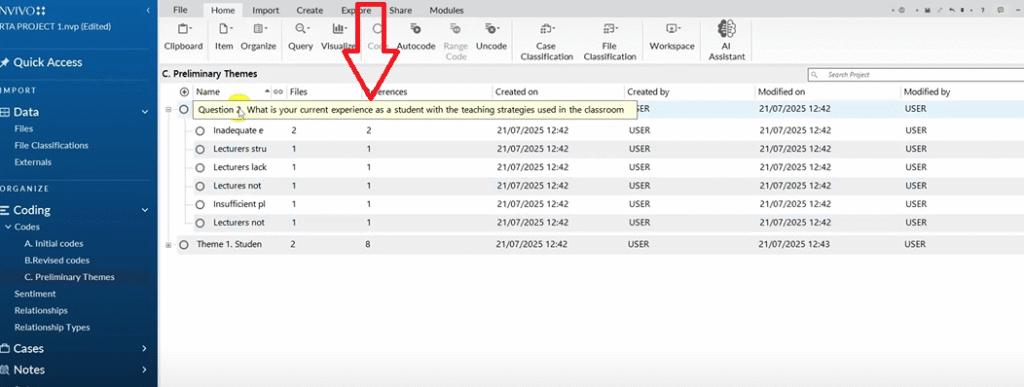
I can rename these question two to experiences with teaching strategies used in the classroom.

Remember these are preliminary themes. I can always change them based on meaning.
This theme represents the diverse experiences that the interviewed student had with teaching strategies used in the classroom across the institution.
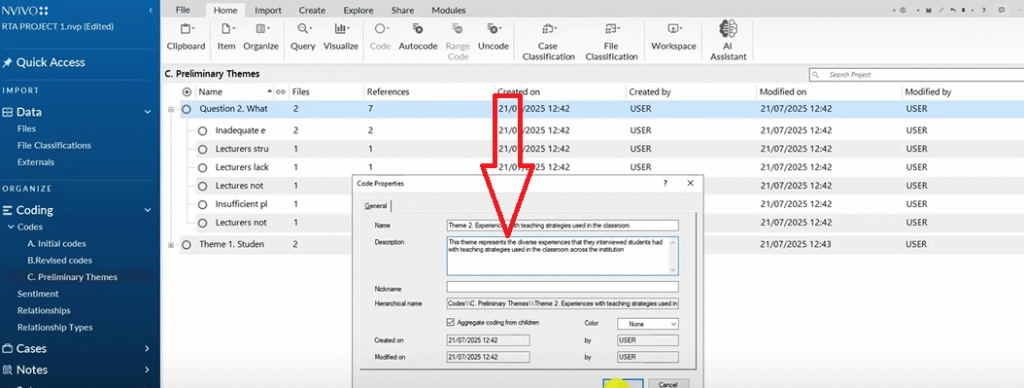
That’s a clear description.
So let’s look at this inadequate explanation from lectures.
Lectures has struggled to adhere to the timetable.
Lecturers lack punctuality.
Lecture has not providing sufficient feedback in sufficient planning.
Lecture not given students sufficient time to digest what they have been taught.
All these experiences are negative.
Actually with that in mind I can go and rename that theme, but let’s do that in the next folder or in the next step.
Remember I’m now doing the other steps of Braun and Clarke together.
So these three steps of reflexive thematic analysis approach by Braun and Clarke it’s like we do them at the same time.
Now, we have a final themes folder.
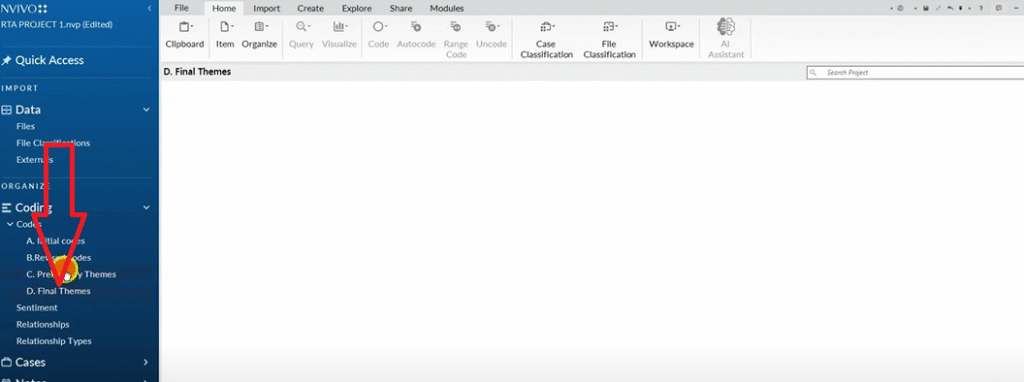
We go and copy the preliminary themes.
We go to the final themes folder we paste.
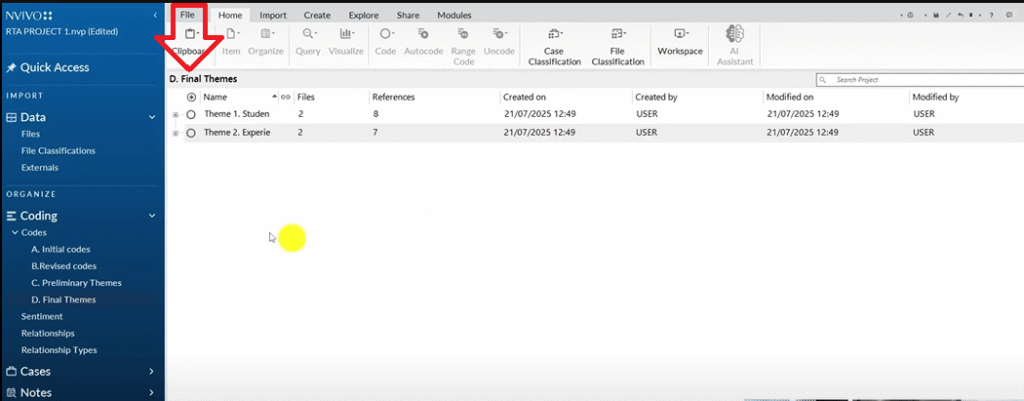
Now let’s review the codes again and ask ourselves, are these themes connected to the codes?
So if I read these Student experiences at the institution, we have positive experiences.
If you remember, this theme represents both positive and negative experiences of students at the college institution.
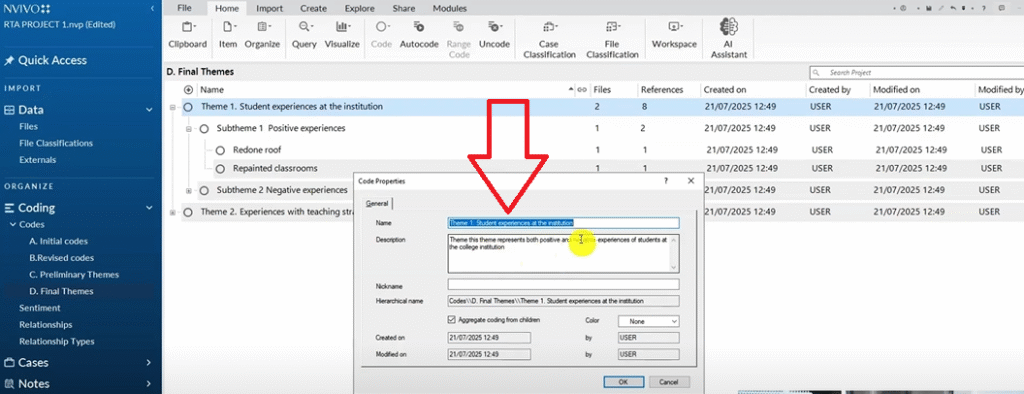
I think that’s a very well done theme, I don’t have to make any changes in the final themes so positive and negative.
Let’s look at the second theme.
If we read the codes again inadequate explanation from the lecturers.
Insufficient planning from the lecturers.
Lecturers lacking punctuality.
Does not given students sufficient time to digest what they’ve been taught.
Lecturers struggling to adhere to timetables.
The lecture is not providing sufficient feedback on assignments.
If you look at those codes, we can now go and edit this to negative experiences with teaching because I have not seen any positive.
Maybe if we coded more we could have found.
So this theme would be better called negative experiences with teaching.
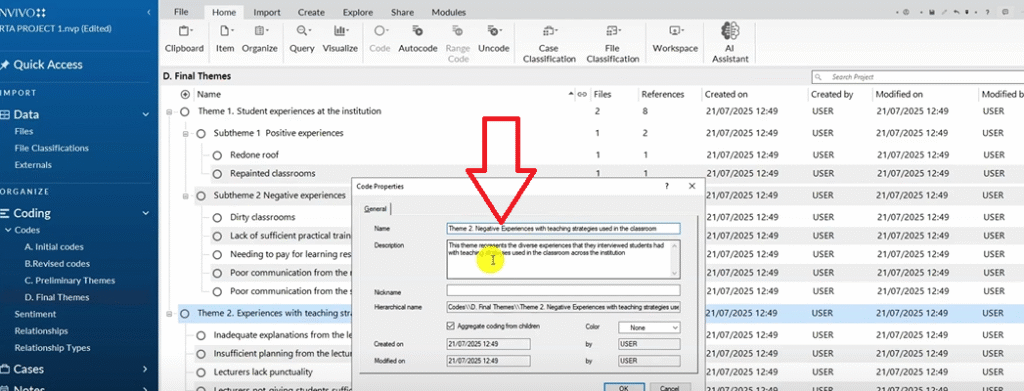
This theme represents the negative, not the diverse. So I edit my description too, of students at the institution.
Again, if I take you back you can see that I handled generating themes reviewing themes and defining and naming themes at the same time.
Those are the five of the first steps that we can do in conducting reflexive thematic analysis by Braun and Clarke.Your Attractive Heading
The final step is producing the findings report for the purposes of just not extending this transcript beyond this point.
I’m going to attach a transcript where I discuss how we write the findings report.
To see how we take the work out of N-Vivo.
And how we write a findings report, this is the sixth step of reflexive thematic analysis by Braun Clark.
Having done that, we can now go to Share.
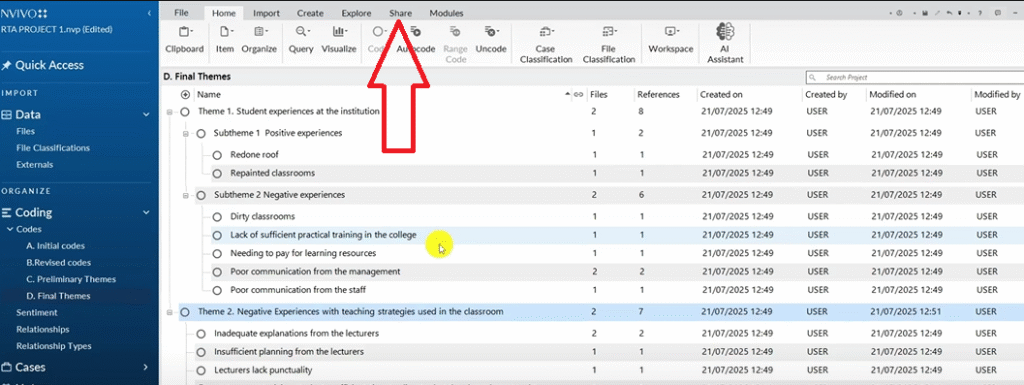
Export.
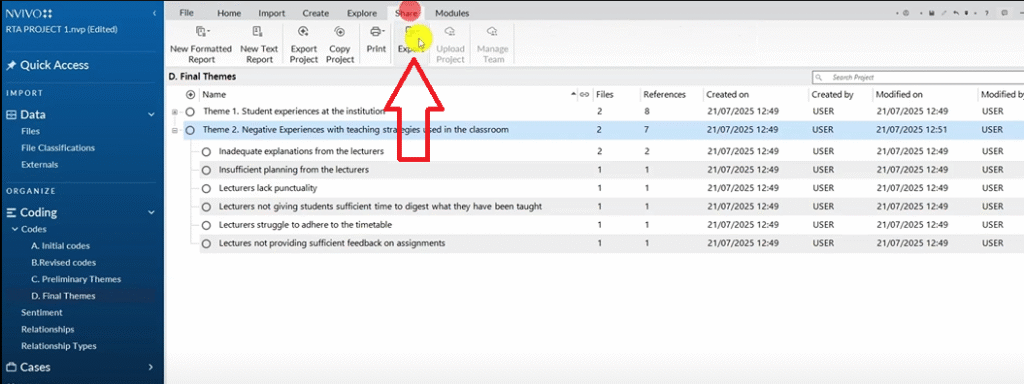
Export Code book.
I would like to export this code book.
So we are going to have a code book with all the codes.
All the descriptions that I was writing.

Also you can use this in your appendix and you can use it to structure your findings report.
So we are able to export a code book after conducting all the steps of Braun and Clarke.
Another thing we can export from N-Vivo after we do coding and we form themes is if you click on these two and go to export.
Export list, we can export an Excel file.

this is the excel file we just exported, this is the coding structure.
Then if I click on number three you can see what I was trying to do.
You can see the color code we are trying to make.
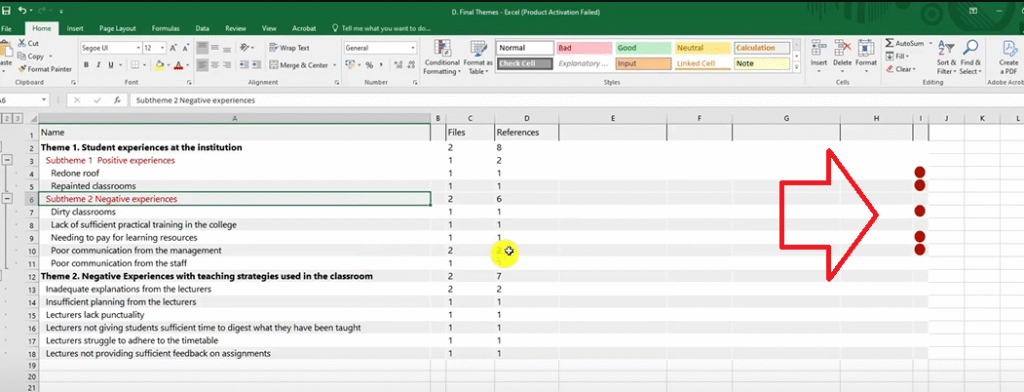
But ideally I use question as containers.
So basically that’s how we conduct reflective thematic analysis in N-vivo.
